
CREATIVE EXPLORATION
AT YOUR OWN PACE
TAP INTO YOUR INNER WISDOM
Welcome to our self-directed art therapy class! Twice a month, we invite you to embark on a journey of self-discovery and healing through creative expression in the comfort of your own home. Each lesson will introduce you to a new theme accompanied by insightful teachings, an engaging creative activity, and thought-provoking prompts designed to promote introspection and reflection. The beauty of this class lies in its flexibility – you have the freedom to engage at your own pace, in your own time. There are no constraints here; take as little or as much time as you need to explore the depths of your emotions and experiences.
COMING SOON
The Art of Authenticity
If this week's activity doesn’t resonate with you, feel free to explore these 75 Art Therapy Activities
created by Expressive Arts Therapist, Emily Sharp, which are organized by artistic medium.
Painting: Activities 1 - 14 Drawing: Activities 15 - 28 Writing: Activities 29 - 38 Collage: Activities 39 - 48
Photography & Digital Art: Activities 49 - 58 Sculpture: Activities 59 - 68 Mixed Media: Activities 69 - 75
Note
The Art of Anger
Anger is a natural, necessary function of being human. It occurs instinctually as a primary emotion, a physical response to something perceived as other. I have always struggled with anger as an outlet for pain and thus have spent significant time considering it, managing it, predicting, and extinguishing it lest I be consumed by it. But I am also comfortable with it, in myself and others. I see anger as pain, simply pain. Overflow from a body replete with pain, a body weakened and unable to carry its mental and emotional burdens.
In his collection of reimagined words, poet David Whyte layers this emotion with even more complexity, not merely feeling pain but caring deeply about that pain: "Anger is the deepest form of compassion, for another, for the world, for the self, for a life, for the body, for a family, and for all our ideals, all vulnerable and all, possibly about to be hurt."
The angriest I've ever been is when I am protecting someone else, which helps me realize anger is more than a release of pain; it is a protection of something that coexists with pain, or rather, the weakened structure pain has wrought—the powerlessness of being. The problem with anger is not that we feel it or even show it; the problem is when it becomes more significant than the pained-weakened self that we are protecting.
Whyte continues:
What we name as anger is only the incoherent physical incapacity to sustain this deep form of care in our outer daily life, the unwillingness to be large enough and generous enough to hold what we love helplessly in our bodies or our mind with the clarity and breadth of our whole being.
However we consider this emotion, and its hand-maidens regret, guilt, and even shame - we might all agree anger is a necessary function and should not be ignored. Things like "don't get angry" might affect the moment, but anger is much more than a moment. I am not against anger, which initially seems wrong because it has negatively affected me and so many people I know - people we all know. And yet, anger is a sparkling moment of aliveness, a plea for help, protection, and compassion. It is caring.
Whyte said it beautifully:
Anger truly felt at its center is the essential living flame of being fully alive and fully here; it is a quality to be followed to its source, to be prized, to be tended, and an invitation to finding a way to bring that source fully into the world through making the mind clearer and more generous.
How do we avoid the anger that harms others? How do we feel and protect our pain, to see its yelp of helplessness rather than fierce barbs? Buddhist monk, teacher, and prolific writer Thích Nhất Hạnh's (October 11, 1926 – January 22, 2022) explored this critical emotion in Anger: Buddhist Wisdom For Cooling the Flames. He sideswipes peripheral noise and deals with the precise moment of anger. What do we do at the moment we feel anger twisting around trying to burn its way out?
Observe Your Anger as Suffering
Echoing the wisdom in his guidance on embracing the present to change the past, Thích Nhất Hạnh advises we be here. In that exact moment of feeling, be still. Rather than focusing on the thing ignited, focus on the anger and you as part of it. "Go back to yourself," to quote Rilke, and do nothing else but that.
When someone says or does something that makes us angry, we suffer. We tend to say or do something back to make the other suffer, with the hope that we will suffer less. We think, "I want to punish you; I want to make you suffer because you have made me suffer. And when I see you suffer a lot, I will feel better." Many of us are inclined to believe in such a childish practice. The fact is that when you make the other suffer, he will try to find relief by making you suffer more. The result is an escalation of suffering on both sides. Both of you need compassion and help. Neither of you needs punishment. When you get angry, go back to yourself, and take very good care of your anger. And when someone makes you suffer, go back and take care of your suffering, your anger. Do not say or do anything.
Controlled breathing and slight, physical movement like stepping outside a room or simply being in touch with the information registered in our senses - what does it smell, what are your feet touching, your hands? What color is the light? Things that return us to our deeply suffering bodies and spirits.
Flood Yourself with Self-Tenderness
Once you've found your body, and reconnected to its suffering, flood it with self-tenderness and care. The house is on fire, focus on the house, not the arsonist. Nhất Hạnh gives us an illustrative metaphor:
If your house is on fire, the most urgent thing to do is to go back and try to put out the fire, not to run after the person you believe to be the arsonist. If you run after the person you suspect has burned your house, your house will burn down while you are chasing him or her. That is not wise. You must go back and put out the fire. So when you are angry, if you continue to interact with or argue with the other person and try to punish her, you are acting exactly like someone who runs after the arsonist while everything goes up in flames.
The metaphor of anger as fire helps keep us separate from our anger and allows us to ask, what do we think of the offense? What does it look like and feel like?
Intellectualize Feeling as a Way to Understand It
Intellectualizing emotions means standing apart and making sense of them as if they were sitting in front of you. It requires self-awareness, even a duality of self. As you stand next to your anger, study it. From this focused thought process comes insight:
When we begin to cultivate the energy of mindfulness, the first insight we have is that the main cause of our suffering, of our misery, is not the other person-it is the seed of anger in us. Then we will stop blaming the other person for causing all our suffering. We realize she or he is only a secondary cause. You get a lot of relief when you have this kind of insight and begin to feel much better. But the other person may still be in hell because she does not know how to practice. Once you have taken care of your anger, you become aware that she is still suffering. So now you can focus your attention on the other person.
This intellectualization of anger is very visible in one of the most thoughtful studies of anger I've ever seen, 12 Angry Men. It's a film that Director Sidney Lumet, in his exceptional guide to filmmaking, said was about "listening." A jury of twelve men, never named, comes together and then falls apart in the quest for justice. As each character works through the case, what they work through is their issues and pain. Pain is expressed through anger. I've turned to the film many, many times to understand anger and pain. We might call it "listening" in Western culture, but it goes back to mindfulness, and it is essential to Nhất Hạnh's wisdom to manage anger in moments and life.
Practice Mindfulness
The core of Thích Nhất Hạnh's teaching is mindfulness, the awareness of ourselves, and pausing at the moment to feel - and celebrate - our incredible aliveness.
One minute of practice is one minute of generating the energy of mindfulness. It doesn't come from outside of you; it comes from within. The energy of mindfulness is the kind of energy that helps us to be here, to be fully present in the here and the now. When you drink tea in mindfulness, your body and your mind are perfectly united. You are real, and the tea you drink also becomes real.
Strive Toward On-Going Compassion
If compassion is the antidote to anger, how do we carry it into the moment of rage? What if, instead of anger, compassion was trigger-ready? If it was ignited as easily and readily as our primary emotions?
If you keep compassion alive while listening, anger and irritation cannot arise. Otherwise, the things he says, and the things she says will touch off your rage, anger, and suffering. Compassion alone can protect you from becoming irritated, angry, or full of despair. So you want to act as a Great Being while listening because you know that the other person suffers so much and needs you to step in and rescue him. But you have to be equipped with something to do the job.
Keeping ourselves alive to compassion, awake to it at all times, is exhausting. And it can leave one weakened and vulnerable to pain. But pain is not the same as weakness; compassion and power are closely aligned. To perfect or even engage in self-loving, we must abandon any evaluation of the object and question of worthiness. And like any art, we will begin poorly, absurdly even.
This is why we have to take good care of ourselves. If you listen too much to the suffering, and the anger of other people, you will be affected. You will be in touch only with suffering, and you won't have the opportunity to be in touch with other, positive elements. This will destroy your balance. Therefore, in your daily life, you have to practice so that you can be in touch with elements that do not constantly express suffering: the sky, the birds, the trees, the flowers, children- whatever is refreshing, healing, and nourishing in us and around us.
There are many ways to turn our anger into something innocuous. In his autobiography, So, Anyway, British comedian John Cleese discusses the anger of Basil Fawlty, Cleese's most iconic character who had a quick temper always triggered. Cleese, who admitted he was raised around his mother's constant anger, essentially turned the emotionally rogue character into a comedic entity. "Funny anger is ineffectual anger," Cleese admitted. He saw Basil's anger as ineffectual, pathetic, and, thus, humorous.
While comedy might disarm anger that comes at us from others, for our anger, something more profound is needed. Something that calls on the pain and soothes it rather than exploits it. Read more in Erich Fromm's generous permission to hold ourselves in the highest esteem, Thoreau's delightful discovery of self-soothing ambles, and Maya Angelou's songs of recovery and triumph.
Reading through Anger, I noticed my version was published in September 2001. While the individual response to 9/11 was one of galvanized love, the overall and lasting response was viler. We might say that September 2001 was a month that marked the triumph of anger over gentle-mindedness. The wars that followed, the tyrants that precipitated it, let anger win. Anger veiled in the political ploy of freedom and security is still anger. What do we lose when we let it burn?
From: Extinguishing Our Explosive Anger: Thích Nhất Hạnh's Pain-Mending Wisdom
Continue Your Learning
Art Supplies
White drawing paper
Markers or heavy-duty pens (preferably in dark colours)
Coloured paper (variety of colours)
Glue stick or liquid glue
Crayons, paint, coloured pencils, or additional markers for finishing touches
Creative Activity
Directions
Now that you're prepared, here are the steps:
Step 1: Acknowledge Your Feelings
Take a moment to sit quietly and reflect on the negative feelings you’re experiencing, especially any anger or frustration.
Allow yourself to feel these emotions without judgment.
Step 2: Select Your Colour
Choose a colour that resonates with your anger or negative feelings. Black, red, and dark blue are common choices. This colour will be used for your first drawing.
Step 3: Express Your Feelings
Using the chosen colour, start making lines, patterns, and shapes on the white drawing paper.
Let your anger come out; you can even write curse words or draw angry faces if it feels right.
Hold the marker firmly, expressing your anger through the pressure you apply.
Step 4: Crumple the Drawing
Once you feel you’ve expressed your anger, pick up the drawing and crumple it tightly in your hands.
Pay attention to the sound and texture of the paper crumpling.
Open it back up and crumple it again, releasing more energy. Do this as many times as you want, the more, the better.
Step 5: Tear It Apart
Now, start ripping the crumpled paper into pieces.
Focus on the act of destruction as a way of letting go of your anger.
Visualize each tear as a release of anger, frustration, and hurt. Whatever it is you're struggling with, rip it up and destroy it.
Step 6: Rip Coloured Paper
Take the coloured sheets of paper and rip them into pieces as well.
Use this as another opportunity to release stored-up energy and emotions. Use up all that energy that you've been storing up in your muscles and in your heart, and get it all out.
Step 7: Dispose of Half of the Ripped Paper
Select half of the ripped pieces (both the original drawing and coloured paper) and throw them away.
Acknowledge that while some negative feelings can be discarded, others may still remain. We rarely get to get rid of all of our negative feelings, some we end up keeping no matter what we do.
Step 8: Create Your Collage
Using the remaining ripped pieces, start collaging them together on a new sheet of paper.
Use glue to attach the pieces, transforming your negative emotions into something new.
Change the shapes as needed by tearing or adjusting the pieces until you’re satisfied.
Take those negative feelings that you just expressed and transform them into a picture that feels healthy, safe, or inspirational.
Step 9: Slow Down and Reflect
As you collage, be mindful of your energy. Take deep breaths, relax your shoulders, and focus on calming yourself down.
Realize that you are not controlled by your negative feelings. You get to choose which feelings you keep and what you're going to react to.
Feel how you have control over the transformation of your emotions.
While you were drawing heavy, crumpling, and ripping, you had raised your heart rate and your breathing pattern, and now you're going to calm yourself down. You’re going to focus and slow your pace. Be aware of what's going on in your body as you do this. Relax your shoulders. Take a deep breath as you're doing this and release it. Try that one more time.
As you continue with your artwork, take another deep breath and gently release it. Notice how much control you have in this moment. You are the one making choices and guiding this process. This is your coping skill—an opportunity to express yourself without being overwhelmed by negative feelings.
Even when life presents challenges, you have the power to create something meaningful from that negativity. It all comes down to perception—how we view the world and the way we choose to respond to it. Ultimately, our perception is the one thing we can truly control, allowing us to transform our experiences into something positive.
It's essential to acknowledge the negativity we encounter, as it shapes who we are. These experiences provide valuable lessons and opportunities for growth, making us stronger as we navigate life's complexities. Embrace this transformation, and remember that you can turn challenges into creative expressions of resilience.
Step 10: Final Touches
Once your collage is glued down, use markers, paint, crayons, or coloured pencils to add shapes, patterns, or images over the collage.
Let your creativity flow naturally, expressing the way you want to feel and the fresh perspective you're shaping.
After you finish your artwork, grab a pen and a journal or notebook and write down your answers to the following questions:
1) How did it feel to express your anger through drawing and tearing paper?
2) What thoughts or feelings came up for you while you were crumpling and ripping the paper?
3) As you created your collage, what did you want to transform your negative feelings into?
4) How did your perception of your anger change throughout this exercise?
5) What did you learn about your ability to control your emotions through this creative process?
6) What will you take away from this experience that you can apply in your daily life?
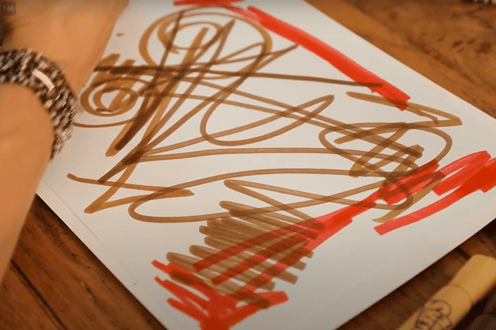
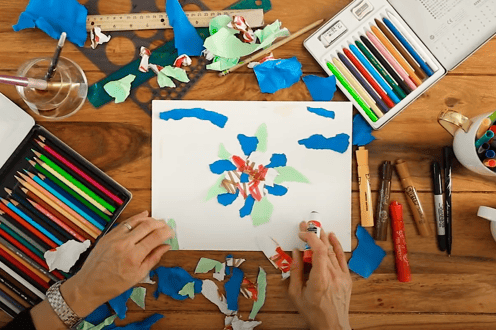
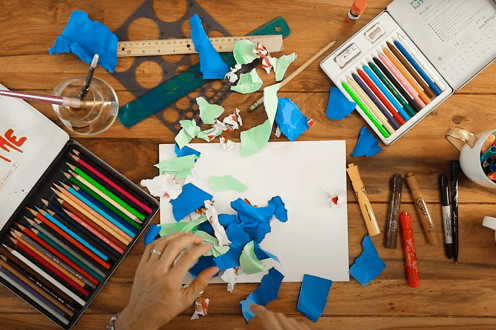
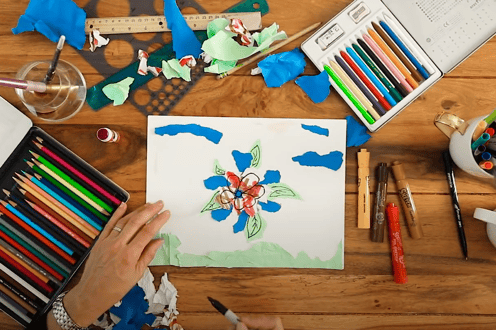




Personal Reflection
Set an Intention
Before you begin, I invite you to close your eyes and take a few deep breaths. Let yourself be here right now in this moment. Turn your attention inwards, place your palms face down on the paper in front of you, and set an intention for this creative exercise. You may choose to say aloud or silently in your heart, "Today, I acknowledge my feelings of anger and frustration. I give myself permission to express and release these emotions through my art. I’m open to transforming these feelings into something new and empowering.” Take a moment to give the paper gratitude for holding space for you today.
Prepare a Calm Space for Creative Exploration
Take a few moments to prepare a peaceful, nurturing space for yourself. You might begin by gently tidying the area and gathering any art supplies you’ll need. When you’re ready, light a candle or some incense to symbolize the start of this journey. If it feels soothing, put on some soft, relaxing music—acoustic, ambient, or nature-inspired sounds can help create a serene atmosphere. (If you’d like recommendations, consider exploring Yellow Brick Cinema on YouTube.) Let the gentle glow of the candle and the tranquil music guide you into a place of ease, inviting you to be fully present for this creative, healing session.
The Art of Authenticity
What does authenticity truly mean to you? For some, authenticity conjures notions of trustworthiness or honesty, while for others, it's about being genuine or real—simply, not fake. In the realm of self-help and personal development, there's a rising trend toward encouraging us to embrace their authentic selves, leaving many to ponder what this elusive "authentic self" actually is.
Authentic individuals are those who strive to align their actions with their core values and beliefs, seeking to discover and then embody their true selves. When actions conflict with their self-concept, it can lead to a spectrum of negative emotions, from mild discomfort to profound guilt.
Though the concept of authenticity remains debated, psychologists Michael Kernis and Brian Goldman proposed an Authenticity Inventory in 2000, comprising four critical factors: 1) Self-awareness: knowledge of and trust in one's own motives, emotions, preferences, and abilities, 2) Unbiased processing: clarity in evaluating your strengths and your weaknesses without denial or blame, 3) Behaviour: acting in ways congruent with your own values and needs, even at the risk of criticism or rejection, and 4) Relational orientation: close relationships, which inherently require openness and honesty.
Besides strengthening our relationships, authenticity is a bedrock of well-being. The trait is correlated with self-esteem, purpose, vitality, and the ability to set and accomplish goals. It’s also linked to coping skills that allow people to navigate life’s challenges in healthy ways, rather than resorting to self-destructive habits such as drugs or alcohol, and it may act as a buffer against the negative effects of loneliness.
Being authentic involves the ability to be introspective and understand what motivates oneself. Such accurate self-knowledge can be a double-edged sword, though, if it reveals uncomfortable truths or weaknesses that one would rather not admit. However, advocates of authenticity argue that in the long run, it’s better to be aware of your shortcomings than ignorant of their existence. Afterall, it’s very difficult to change something that you’re unaware of.
Developing authenticity is an ongoing process. To begin, reflect on your values. What changes can you make to live in accordance with those values? You can observe yourself objectively (pretend that you’re a fly on the wall or assessing someone else) and observe which actions and choices feel authentic and which do not. Examine belief systems that you developed in childhood or ingrained patterns that no longer serve you—understanding the roots of current beliefs can help you move forward.
Genuine people share a few key traits. They tend to take time to develop an opinion and speak their mind, respond to internal expectations rather than external ones, and forge a unique path to fulfill their passion and purpose. They aren’t threatened by failure and can admit their faults. They are often less judgmental of others and have strong self-esteem.
Embracing authenticity demands courage and vulnerability. It requires revealing your true self, risking disapproval or rejection. Additionally, it entails continual self-evaluation and mental energy, as individuals navigate the complex interplay between values, actions, and social expectations. Authenticity isn't a static state but a dynamic process—one that requires ongoing introspection, self-discovery, and courage to live authentically in a world that often values conformity over individuality.
From: PsychologyToday
What It Means To Be Authentic
‘All human beings wear a mask’ used to write Italian novelist Luigi Pirandello. If you ever had this feeling, we are here to tell you it’s more normal than you would think. Whatever the reason, sometimes it might happen that we behave in a way that doesn’t feel true to who we are. For example, instead of being yourself, you might play a role in order to fit in or to impress others.
“To be yourself in a world that is constantly trying to make you something else is the greatest achievement.” – Ralph Waldo Emerson
Living inauthentically can be caused by many reasons, among which are the desire to please, the need for confirmation, or the wish to belong to a particular group and be accepted. But is it actually enabling us to lead the life we want for ourselves? Although sometimes this might feel like the easiest way to blend in, not being true to who we are can be exhausting, and limiting, and it can prevent us from reaching our true potential.
What is Authenticity?
What do we exactly mean by ‘authentic life’? Well, there are almost as many definitions of authenticity as there are psychologists, philosophers and scholars. The definition we will be using in this guide comes from psychology professor Stephen Joseph and reads:
“Knowing yourself + owning yourself + being yourself = leading an authentic life”
Each element in this definition has its own meaning, namely:
Knowing yourself entails being aware of your personality, values and needs. You know what you want and what you don’t want;
Owning yourself means that you can trust yourself, what your opinions are, what you think, your choices and how you behave;
Being yourself entails that you behave in accordance with your personality, values and needs. You don’t let yourself be influenced by the expectations of others.
Together, these elements lead to you living an authentic life, where who you are, what you stand for and how you behave are aligned.
Benefits of Living Authentically
How would you feel if every day you said what you meant, remained true to yourself and behaved accordingly? ‘Fulfilled’, would be my first thought. Well, science backs me up here.
Many studies demonstrate that there is a great number of positive effects linked to living authentically. Let’s see some of them.
Happiness and satisfaction: research shows that living authentically makes us happier and more satisfied with our lives;
Stress: research shows that being authentic is way less stressful than trying to be someone who you are not;
Confidence and self-worth: When you can trust yourself to make the right decisions, this will increase trust in yourself, feelings of self-worth, optimism and satisfaction in your life. Another interesting fact? The way you treat and feel about yourself is radiated towards others, so when you trust yourself you invite others to trust you as well;
Intrinsic motivation: Research also shows that people who live an authentic life are more likely to show gratitude and engage in socially conscious activities such as voluntary work;
Increased problem-solving abilities: When you are honest with yourself and others, you have the ability and open-mindedness to quickly deal with problems instead of procrastinating or ignoring them. This means you actively take action on what you think is important and have fewer doubts.
These are only some of the many benefits of leading an authentic life! Sounds great, right? Yet, saying and doing are two very different things. So, how do we switch from theory to practice? How do we actually become more authentic? And what makes this hard to do and stick to?
Developing Authenticity
An important first step to living a more authentic life is to get to know yourself better and explore what you find important in life. It’s all about becoming more aware of your personality, values and needs.
Ask yourself: what do I find important in my work, relationships, and free time? What are the things that really move me? What do I like and even more, what do I dislike? What am I good at? How would I ideally live my life?
These are big questions, we know. And it’s totally okay if you don’t have the answers yet and you don’t feel like knowing yourself in this way. It takes time and it’s a lifelong process. The things we want, our goals and desires of course change over time and different things will gain different importance over the stages of life.
Our goal is to help you take the first steps in the direction of leading a more authentic life. There are many exercises that can help you find a way to understand yourself better. Let’s try some of them together.
Visualisation Exercise
Let’s imagine that it’s your 80th birthday party, all your loved ones are present and they all would love to give a speech about you. What would you want them to say in this speech? Take a moment to reflect on the following questions:
What do you imagine you have meant to others?
What do you wish to have accomplished?
What kind of person do you wish to be?
What came to your mind? Any words or images? If you can, write those down. The answers to these questions say something about what you think is important in life.
“If you have an idea of what’s important to you and what your values are, you’ll be better at navigating your way through life. That ends up being pretty satisfying.” – Jasmijn Eerenberg
When you have a greater awareness of what you find important in life, you have taken the first important step towards being more authentic. The next thing to do is to find out how you can live according to these values.
Losing Authenticity
Even when we have formulated clear and concrete steps to follow the path towards living a more authentic life, it can still happen that we go off track and lose our sense of authenticity.
If this is the case, do not lose hope! To deal with these situations it is important to first recognise that you are feeling or behaving inauthentically and to pinpoint the reason behind it happening.
Often, the main cause is our internal limiting beliefs. These are beliefs or thoughts that tell us what we should or shouldn’t do. Examples of these limiting beliefs are shortage of time or money, constant comparisons to others, fear of disappointment, desire to fit in, and lack of self-confidence.
“If we want to live authentically, we need to be prepared to sit with feelings of discomfort for a bit, because it is only when we step out of our comfort zone, that we can challenge these beliefs and move forward on the route of authenticity.” – Emma White
Practical Exercise
It is important to know that we all experience one or more of these limiting beliefs at some point in our lives. However, it becomes a problem for us if these get in the way of doing the things that are important to us.
Take a moment to reflect on your own possible limiting beliefs by answering these questions for yourself:
What is getting in your way to live authentically?
What is your biggest barrier?
What might be blocking your path to living in accordance with what you find important?
Stick With What You Find Important
There are several tips to keep in mind when we want to stay closer to our values. Below are the most important ones, according to our psychologists:
Build your self-trust: an exercise that enables this is called the Feedback fast. Be aware of when you feel the urge to ask for confirmation or advice from others. When this happens, try the following:
Keep track of when this happens and what happens when you stick to your gut. Doing this will help increase your trust in yourself.
Notice the motives or matters for which this happens.
Compare your present self with your younger self. Where are you now compared to one, five, or ten years ago? How have you grown?
Schedule regular reflection moments: take a break to reflect on how you are doing, on what is going well and what could be going better and whether you are living in accordance with what you find important.
How can you deal with limitations: take note of your limiting beliefs or other obstacles and reflect on how you might deal with them once they occur. This can help you to remain on the right track and feel capable to deal with them when they come up. Remember to also keep track of your successes and keep in mind the benefits of living an authentic life. The more you step out of your comfort zone, the more your confidence will grow to continue on your path.
Step Up to Your Real Self
When we lead an authentic life we feel fulfilled by our actions, choices, and connections and we bloom into the best version of ourselves. Living authentically also means accepting who we are with honesty, with all the unique facets of ourselves. It requires us to overcome our limiting beliefs and take control of our thoughts and behaviours to be more in touch with our real selves.
Keep in mind that knowing what is important to you and what your values are isn’t always something you can figure out from one day to another. It is a life-long process. Therefore, be patient and show yourself kindness if you don’t know what you want right away.
The following questions can help you to gain more insight into what is important to you. Write them down and try to answer them in as much detail as possible.
What did you really enjoy or do well as a child?
What does your perfect workday/relationship/day off look like? What are the most important elements?
What are some moments or periods that have made you feel inspired? Why was that?
Which books, films, and conversations have really moved you? Why was that?
Who have you admired in the past or who do you admire now? Why is that? What does this person stand for?
Take your time to find the real you at your own pace. You will discover something new with each step and you will get closer and closer to living your most authentic life.
Articles
8 Ways to Cultivate Your Authentic Self
What the New Science of Authenticity Says About Discovering Your True Self
Twelve Examples of Authenticity: What Being Authentic Looks Like
Are You Truly a Genuine and Authentic Person?
Videos
What is Meant by "Authenticity"?: Gabor Maté (7 minutes)
Being Authentic - Learn to Love Ourselves and Find Self-Worth (10 minutes)
The Power of Authenticity (14 minutes)
Freedom to Be Yourself (10 minutes)
Continue Your Learning
Art Supplies
Mask (you can use an actual mask or a paper template)
Mod Podge or Glue
Tissue Paper
Scissors
Magazines
Coloured Paper
Colouring Supplies (markers, pencil crayons, paint, pens, crayons)
Feathers, Pom Poms, Stickers, Felt, Foam, etc.
*You can also include any other materials that you would like to use to decorate your mask.
Creative Activity
Directions
Now that you're prepared, here are the steps:
Step 1: Decorate the outside of the mask, representing how you think others or the outside world sees you (the outer you).
Step 2: Decorate the inside of the mask (or the other side of the paper if you're using a printed template), representing how you see yourself (the inner you).
There is no wrong way to do this activity, and you can choose to use any materials that resonate with you.
Using a mask is perfect as a metaphor for exploring the different aspects of ourselves. Masks possess a captivating allure that draws us in, stirring emotions, and holding a rich tradition across many cultures. They symbolize a potent means of sharing our human experiences but also hiding them from others.
Creating the mask enables us to articulate thoughts and feelings that may have remained unexpressed. It encourages profound introspection into our identities, the personas we project externally, and how they compare to our internal selves. This activity assumes that we all wear masks, revealing and concealing different parts of ourselves to the outside world. Recognizing and acknowledging these natural parts of us is important. The process aids in fostering greater self-awareness and acceptance of our multifaceted identities and encourages us to embrace the entirety of who we are.
After you finish your mask, grab a pen and a journal or notebook and write down your answers to the following questions:
1) Describe the inside and outside parts of the mask, how are they similar? How are they different?
2) How do the outside and inside aspects of you relate to each other?
3) What barriers prevent you from showing your true self to others? How can you overcome these barriers?
4) How can you integrate more of your inner self into your outer life? What steps can you take to be more authentic?
5) What have you learned about yourself through this mask project?
From: Thirsty for Art
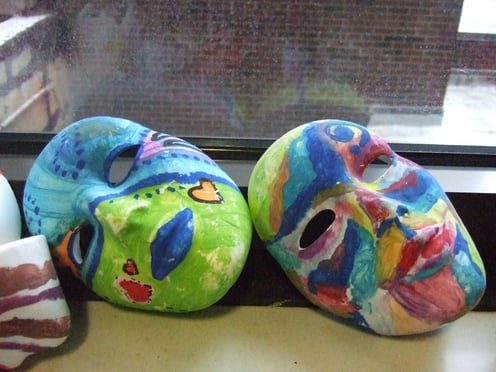

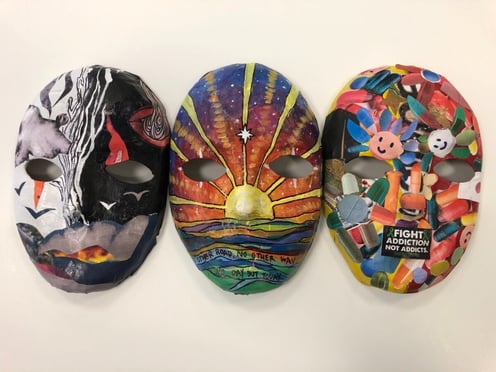
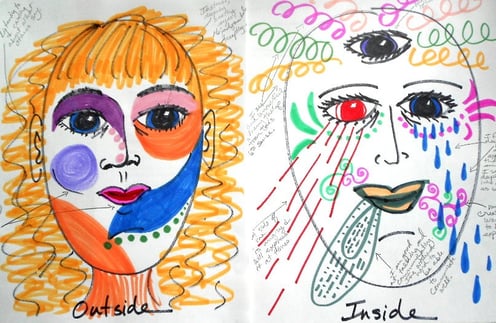
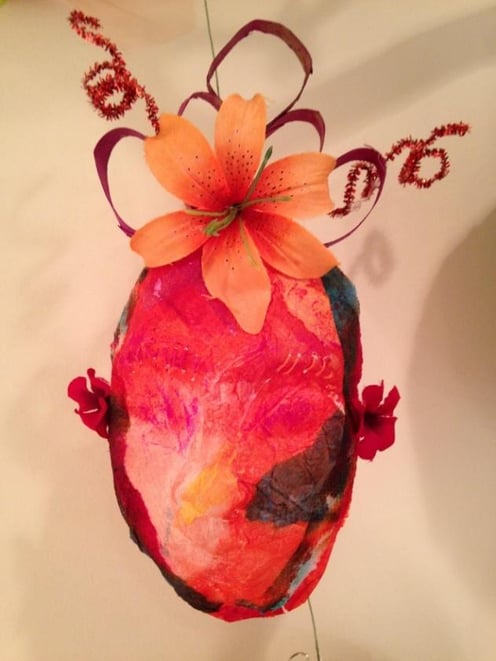
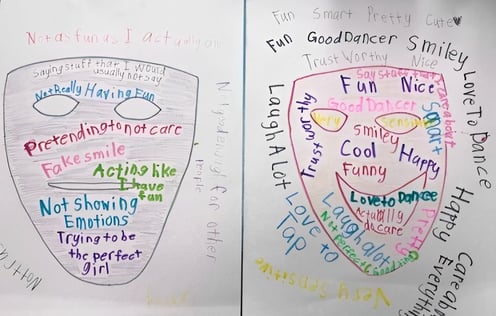






Personal Reflection
Set an Intention
Before you begin, I invite you to close your eyes and take a few deep breaths. Let yourself be here right now in this moment. Turn your attention inwards, place your palms face down on the paper in front of you, and set an intention for this creative exercise. You may choose to say aloud or silently in your heart, "I choose to be authentic in my creative expression. As I create, I will explore what feels genuine and true to me, without judgment." Take a moment to give the paper gratitude for holding space for you today.
Prepare a Calm Space for Creative Exploration
Take a few moments to prepare a peaceful, nurturing space for yourself. You might begin by gently tidying the area and gathering any art supplies you’ll need. When you’re ready, light a candle or some incense to symbolize the start of this journey. If it feels soothing, put on some soft, relaxing music—acoustic, ambient, or nature-inspired sounds can help create a serene atmosphere. (If you’d like recommendations, consider exploring Yellow Brick Cinema on YouTube.) Let the gentle glow of the candle and the tranquil music guide you into a place of ease, inviting you to be fully present for this creative, healing session.
The Art of Sadness
Last week during our in-person class, we explored an emotion we all cherish: happiness. We live in a happy-obsessed society, constantly bombarded with happy smiling faces on TV and billboard ads telling us their version of happiness. Even worse, we see our friends and family members on social media posting photos of their joy-filled lives; but never sharing any raw feelings of what’s actually going on beneath the cheerful facade. It's an unspoken law that we all want to be happy, but the reality is that happiness can often be fleeting and difficult to find. This week, we'll explore happiness' opposite: sadness.
Sadness is complex and describes a range of emotional states we can experience containing everything from mild disappointment to extreme despair and anguish. It can also be experienced along with other emotions, such as anger (e.g., having a loved one abandon you), fear (e.g., that we will not be able to cope or move on with life), and even joy (e.g., reminiscing about time spent with the lost person or thing; pleasure from the comfort provided by others).
It's easy to think of our negative emotions as inconvenient, unnecessary, and unwanted. But they all have a purpose. Fear protects us from situations that may cause us harm or get us into trouble. But when these feelings become too intense or persistent, people avoid doing things that they need to do. Joy lets us celebrate and be grateful. But when we try to force joy to be present, this emotion can be short-lived and feel unsatisfying. Anger defends us and can empower us to seek justice. It’s a very important emotion, but used too often or incorrectly, we become irrational, emotionally reactive, and impulsive. Uncontrolled anger can lead to bad decisions that we regret and actions that damage our relationships.
People seem to find purpose for these three emotions, whether or not they always use them well. Sadness is everyone’s least favourite, but sadness is an important emotion that must be experienced outwardly and not suppressed. This is not to suggest that prolonged sadness, which can lead to depression and hopelessness, is the goal. Rather, allowing ourselves to be sad when something bad happens—when we lose a loved one, when we experience rejection, or when we feel lonely—can give us insight into our desires and our needs. We must acknowledge that we feel sad and even allow ourselves to shed tears, which is part of the healing process. While neither glamorous nor fun, shedding tears provides a release that helps heal our body and our brain from sadness, disappointment, and grief.
What is the purpose of sadness?
The foundational human emotions include joy, fear, anger, disgust, and surprise. Sadness belongs on this list, too. It may not feel like positive emotion, but there are some surprising benefits of sadness:
1. It helps us feel strong in the face of adversity: Even the fiercest fighters know how important rest is, and sadness lets us do just that. When we’re feeling sad, we might feel tired, sluggish, and less receptive to the world. But what are our body and our mind telling us? To regain our strength. By giving ourselves the permission to feel sadness, we’re actually regaining our strength.
2. It forces us to confront what’s happening to us: When we’re sad, we look inward to identify what’s bothering, hurting, or angering us. When we know what’s hurting us, we can start healing.
3. It tells others we need help: When we’re sad, we can’t help it. We wear it on our sleeves. Showing our emotions can help signal that we need support. And for your support system, it’s important they’re attuned to your emotions. That way, other people that we’re going through something and may need their help.
4. It reminds us of life’s meaning: Sadness acknowledges the special role of things in our lives. If we’re sad about a fight with a friend, it’s because that person is important to us. If we’re sad that we didn’t get a job we applied for, it’s because we care about our career development. In a lot of ways, sadness reminds us of our personal values, our purpose, and our passions.
5. It teaches us to adapt: Life is full of things we can’t avoid. But sadness is a great teacher. What makes us sad now might not be so hard later because we’ve learned to adapt and be resilient.
6. It connects us with others: Sadness is a vulnerable emotional state. But when we share it with others, we form bonds by invoking their empathy.
The function of sadness
Human emotions are the result of millions of years of evolution. They serve specific purposes that are instrumental in our survival. Fear, for example, helps us avoid vicious predators, while anger boosts our adrenaline so we can defend ourselves.
There’s a lot we don’t know about how sadness works. But, so far, scientists can say that sadness has the following effects on people:
It improves our memory. When we’re feeling blue, we tend to notice and remember small details in our environment. On the other hand, things tend to blur together when we’re happy — giving credence to the expression “time flies when we’re having fun.”
It improves our judgment. Sadness reduces the influence of our cognitive biases, including how we perceive others. For example, we’re less likely to make positive or negative assumptions about someone based on their appearance.
It motivates us. When we’re sad, we’re reminded that something is amiss. It’s a wake-up call to make some positive changes.
It deepens our interactions. The vulnerability of sadness lets us empathize with others. This can allow for deeper interactions and meaningful connections.
It makes us kinder people. We’re more likely to extend a hand to others because we would like them to do the same for us..
Here are three tips for allowing yourself to be sad in healthy ways:
1) Keep a journal and write entries when you feel sad. Reflect on what you are sad about, and describe how you feel. Write about what has happened that has led to your feeling. It doesn’t have to be a long narrative; it can even be bullet points. But it documents that you allowed yourself to be sad, and you can reflect on it later, when you feel differently.
2) Set aside time to reflect on experiences that may evoke sadness. If you tend to be someone who tries to distract yourself when you feel sad, resist the temptation. Take a few minutes to sit with this feeling and remember that all emotions are temporary, but it’s important for every emotion to be acknowledged. Mindful acceptance of all emotions facilitates a healthier healing process.
3) If you’re tired of being sad, and you have felt this way for a while without relief, consider talking to a therapist. This will give you a safe space to share your feelings and to process why they persist.
Our modern culture often sends false messages that we are not supposed to be sad, and if we do experience sadness, there is something wrong with us. We must be depressed. But sadness is not depression. Sadness is acknowledging that we are feeling the loss of something. So, allow yourself to feel sad, and ironically, it will eventually lead to acceptance, resilience, and hope for the future.
From: How to Appreciate the Healing Power of Sadness and It’s OK to Be Sad. Here's Why You Need Some Sadness and How to Use It
Articles
Four Ways Sadness May Be Good for You
It’s OK to Be Sad. Here's Why You Need Some Sadness and How to Use It
8 Tips for Healing Emotional Wounds
Videos
How to Deal With Intense Emotions: A Therapist's Approach to Grief and Sadness (7 minutes)
Why Sad Movies Are Good For Us (6 minutes)
Why We May Be Angry Rather Than Sad (4 minutes)
Continue Your Learning
Art Supplies
Mixed media paper
Watercolour paints
Pencil crayons or felt markers
Paint brushes
Jar filled with water
Creative Activity
Directions
Now that you're prepared, here are the steps:
Step 1: Trace both of your hands, palms facing up, onto the paper using a marker or pencil crayon.
Step 2: Take a moment to open your heart fully, creating space to gently welcome sadness. Allow yourself to feel its weight and presence without judgment, letting it be part of your emotional landscape for a while. Embrace the stillness it brings, knowing it can offer deeper understanding and healing.
Step 3: Pour it out onto the paper using colours, shapes, lines, and symbols. Let your sadness spill out from you and keep breathing through the process. You may also choose to write words or sentences on the paper as they come to mind.
Step 4: Start to give life to your hands, allowing them to hold and honour your sadness. Add colours and images to bring them to life, and permit yourself to feel your sadness without judgment. Let it rest in the palms of your hands. Cradle your pain, acknowledging it with gentleness and compassion.
After you finish your artwork, grab a pen and notebook and write down your answers to the following questions:
1) What specific colours and shapes did you choose to represent your sadness, and why do you think you were drawn to them?
2) What do you notice about the way your hands are holding your sadness? Is there a specific way you’ve positioned them that holds particular significance for you?
3) Can you identify any areas within your drawing where your sadness feels more intense or lighter? What might these variations signify for you?
4) How does it feel to see your sadness visually represented in your hands? Does it change the way you perceive or understand your sadness?
Set an Intention
Before you begin, I invite you to close your eyes and take a few deep breaths. Let yourself be here right now in this moment. Turn your attention inwards, place your palms face down on the paper in front of you, and set an intention for this creative exercise. You may choose to say aloud or silently in your heart, "I open my heart and invite sadness in. I allow myself to fully experience my sadness at this moment." Give the paper gratitude for holding space for you today.
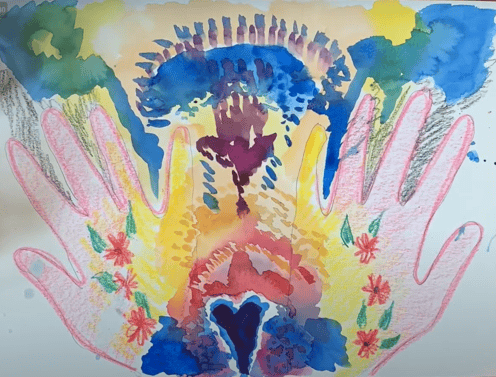
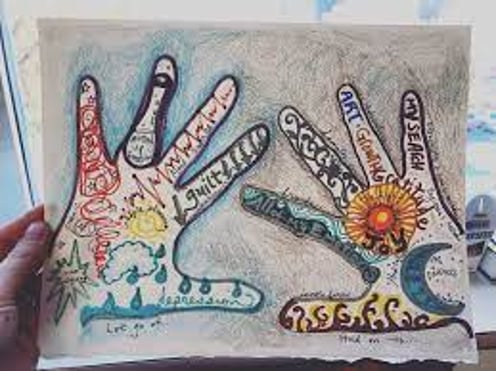
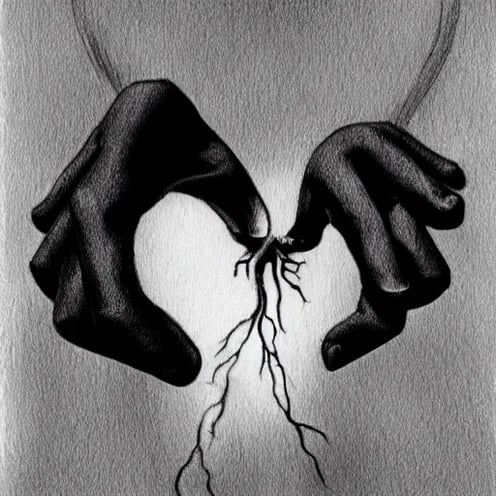
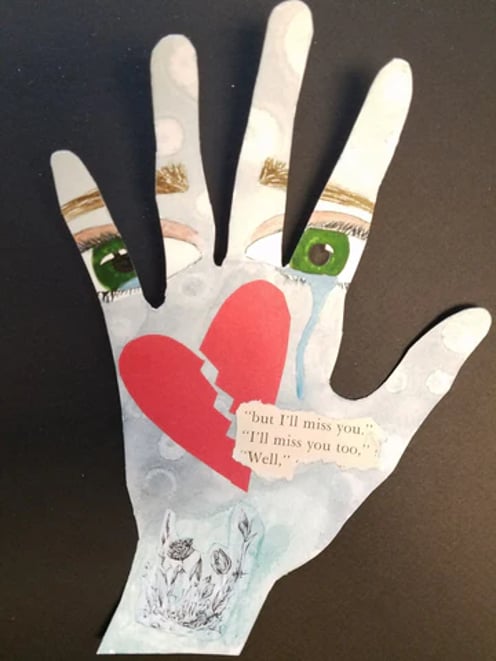






Personal Reflection
Prepare a Calm Space for Creative Exploration
Take a few moments to prepare a peaceful, nurturing space for yourself. You might begin by gently tidying the area and gathering any art supplies you’ll need. When you’re ready, light a candle or some incense to symbolize the start of this journey. If it feels soothing, put on some soft, relaxing music—acoustic, ambient, or nature-inspired sounds can help create a serene atmosphere. (If you’d like recommendations, consider exploring Yellow Brick Cinema on YouTube.) Let the gentle glow of the candle and the tranquil music guide you into a place of ease, inviting you to be fully present for this creative, healing session.
The Art of Change
“The only constant in life is change.”
That quote from the 6th-century Greek philosopher Heraclitus is as accurate today as it was when he said those words.
Change is inevitable for every one of us. We experience positive and negative change in small moments throughout our day and in large, life-altering events.
I’m sure you can think of several examples of personal and professional change you have experienced.
It may be something minor. Maybe your business client cancels a meeting, freeing your schedule to make additional sales calls, close new customers, and increase your commission.
Or change might have a more significant impact on all areas of your life. Maybe a family member needs more of your time because a serious car accident left them temporarily incapacitated.
Whether beneficial or harmful, enjoyable or depressing, change is inevitable and something everyone experiences. It’s how you face it that determines its impact on you. How you use it to enrich your life or overcome it to move forward to a better life.
The better you can adapt to life's circumstances by embracing change, the more successful you will be personally and professionally.
Eight positive benefits you can achieve by embracing change
Change often appears when least expected, and it is easy to think of change as negative. But embracing change enables you to see its powerful positive impact.
1) Embracing change drives growth in all areas of your life.
Most of us don't like change because it forces us to do things we are not comfortable doing. It pushes us outside our comfort zone and makes us feel “un”comfortable.
Because we have no control over change, we must learn and do new things. This enables us to grow and exposes capabilities, skills, and expertise we didn’t realize we possessed but had within us all along.
2) Embracing change helps you be adaptable and flexible.
Being comfortable means that we can be set in our ways, doing things the same way over and over again because it is easy or helps us feel confident and secure. In fact, we feel more insecure, vulnerable, and stress-filled when we lack the ability to adapt to new situations that change presents.
When we embrace change, we are adaptable to new circumstances, situations, and people and lean into the opportunities they offer. Welcoming change with enthusiasm enables you to uncover opportunities for improvement and advancement. You might never have discovered these opportunities if you were not open to grabbing them without hesitation.
3) Embracing change enables you to validate and re-evaluate your ideas and opinions.
We go through life meeting every new experience with an established set of ideas, opinions, and beliefs. This isn’t necessarily a bad thing. It just is what it is.
But, if you meet someone with completely opposing views and ideas or have an experience that causes you to question your established beliefs, you may discover that your point of view changes. It can cause you to reassess your life or career, reinforce the views you already have, or support your preexisting decisions and help you accomplish even greater goals.
4) Embracing change exposes your strengths.
How you react to life’s changes shows you what you’re made of. It exposes strengths inside you that you were never aware of or didn’t believe you possessed.
5) Embracing change lets you learn new things—and fail.
Continuing to live in a comfortable environment doing the same old, same old does not enable you to grow. It’s only in failure that you learn your biggest lessons and can emerge on the road to success. The more we embrace change, the more life experiences we have, and the more we learn about others and ourselves.
6) Embracing change gives you the guts to do more.
As you do more of anything in life, you become better and better at it. The same is true with change. Each time change makes you face a situation or an environment in which you are uncertain or uncomfortable, and you overcome your anxiety, you gain confidence that the next time the situation will be easier to handle. And the next time, even easier. And easier.
While change can be challenging, the fear is removed, and the anticipation of greater opportunities and advancements comes into view. Your confidence builds as you regularly embrace change, gain confidence, and meet small goals. As a result, you are more likely to follow through on and achieve larger goals.
7) Embracing change lets you handle setbacks and appreciate success.
Setbacks are inevitable. Never will everything go perfectly for you. Embracing change means that you can be positive or at least be content in the knowledge that things will get better in the face of seemingly insurmountable obstacles.
The hidden benefit of a setback is that it makes your success even sweeter because you are aware of what you have overcome.
8) Embracing change lets you retake the direction you want to go.
You are in the driver's seat when you accept or lean into change. Of course, you will not always pick the right road to travel, but it enables you to take control of the wheel and be an active driver, so to speak. You can change course or take an exit if needed.
Rather than being a passenger with no opportunity to steer the car, you can be proactive, take control of the direction of your life, and live the life you want.
Four ways to embrace change
Putting a mindset of positive evolution, progress, and advancement into practice is certainly easier said than done, but it enables you to both benefit and learn from happy opportunities and unwelcome challenges as they come your way.
When a new situation presents itself, consider how you perceive the change. What is your first thought? What is your first reaction? Human nature often drives us in the direction of a negative response.
You may be offered a job promotion but feel, “I can’t take that job. I’m not qualified. I wouldn’t know what to do.”
Embracing change starts with adopting a positive mindset. One that enables you to expand your circle of experiences and knowledge and helps you grow. Instead of saying, “I can’t take the job. I’m not qualified. I wouldn’t know what to do,” say to yourself, “I will learn what I need to know. Other co-workers will show me the ropes until I feel comfortable in my new role. It may take a few months, but I can do it.”
Both positive and negative challenges provide us with teachings, insights, awareness, and understanding. We collect each of these, taking them with us throughout our lives, making us better and more well-rounded friends, co-workers, parents, spouses, and siblings.
Let’s look at a few more examples of embracing change.
Rather than saying, “There’s no way I’m ever going to figure this out,” say to yourself, “It may take more time than I thought, but I will do it.”
Rather than saying, “I failed,” say to yourself, “I didn’t succeed this time, but I gained some valuable insights and will use what I learned to succeed next time.”
Rather than saying, “This isn’t working, so I give up,” say to yourself, "What I'm doing right now isn't working, but if I use a different tactic or strategy and come at this challenge from a different direction, it may work.”
Embracing change causes you to be aware—to see things differently. To see difficulty as an opportunity to grow. To expand beyond yourself and the comfortable bubble we all like to live within. To try new things.
Be bold. Enlarge your perspective on life and people.
"What Doesn't Kill You Makes You Stronger" comes to mind here. We are stronger and more resilient than we know or give ourselves credit for. It is only when we overcome seemingly overwhelming challenges that we learn what we are really made of.
Originally published in 1889 by German philosopher Friedrich Nietzsche in his book Twilight of Idols, his quote, "What Doesn't Kill You Makes You Stronger," continues to be popular today. Singer Kelly Clarkson included it in the lyrics of her song Stronger, released in 2011.
Over time, embracing change becomes easier and easier as you overcome each new challenge and accept uncertainty head-on. Here are five actions you can take to embrace change and steer a course through uncertainty successfully.
1) Be courageous and live without regrets
Each of us only has one life to live, and life goes by very quickly in the grand scheme of things. We never know when our last day is, and that’s probably a good thing. On the other hand, we often act as if we’re going to live forever, put things off, and say we’ll do it later.
“I’ll start traveling after I retire.”
“I’ll go back to school to get my degree after my children are adults and on their own.”
“I’ll move across the country to live in my dream city when I am more financially stable to make the move.”
Your retirement, your child's transition to adulthood, or financial stability may come years or decades from now. Is that really why you're putting off the opportunity to travel, get your degree, or move to your dream city, or are you afraid to take the first step?
On the other hand, if you knew you only had one year to live, how would your life change? You would most likely say you will be an active participant in life. You will do those things you dreamed of doing before you die. You’re going to start traveling. You’re going to finish your degree. You’re going to pack up and move.
But why are you doing this?
I ran the corporate marketing departments for large technology companies and fast-growing startups for 30 years. For decades I wanted to become an entrepreneur and own my own marketing consulting business. I always came up with reasons why I couldn’t do it.
I had responsibilities to the company I was working for.
I didn't have enough financial resources to bootstrap my business successfully.
I had personal responsibilities that took priority.
Finally, at almost 50 years old, I looked around and wondered where the time had gone. I realized that if the second half of my life was going to go as quickly as the first half, I was in for a speedy ride. At that moment, I decided I had to make a move.
I had to start my own business, no matter my personal or professional situation at the time. It was my dream. My “excuses” for not starting the business were pushed aside by one powerful thought.
“I don’t want to come to the end of my life and regret what I never tried. If I start my own business and it is successful, it will be fantastic. I’ll be living my dream. If I try and fail, what’s the worst that can happen? I can always go and get another job working for someone else. No one will think less of me. At least I know I tried.”
In the end, I did start my business, TECHmarc Labs, and its success has led me here.
2) Find a community of supporters
Embracing change is so much easier when you have someone on your side who is cheering you on. They help keep things in perspective, offer alternative points of view, act as a sounding board to listen to your challenges, share ideas, motivate you when times get tough, and celebrate your wins.
These supporters don’t have to be expensive life coaches or high-powered mentors. You can join a mastermind group of other like-minded people with similar goals. You can ask a close friend, a family member, or a work colleague to help you stay motivated and on track to achieving your goals.
You don’t have to spend a lot of money to get the support you need. You need one person or a community of people who are honest, supportive, and have your back.
3) Continually open your mind to new things and experiences
Life is full of uncertainty. I wrote a whole blog post talking about the benefits of accepting uncertainty.
Even when your road through life gets bumpy, it is a teachable moment—an opportunity to gain insight. To learn something new. To challenge your beliefs. To face an uncomfortable situation.
If you never open your mind beyond your fixed environment, you will continue to live in the situation you are currently in. You will never expose yourself to new opportunities for growth.
Continually open your mind to new things and experiences and keep learning.
4) Stick with it – persevere!
It’s easy to look at celebrities and think they have achieved overnight success. We live in a world of immediate gratification and assume that our journey to success, wealth, happiness, or whatever we desire will happen overnight.
American actor, singer, and comedian Eddie Cantor said, "It takes 20 years to become an overnight success." That is so true and one of my favorite quotes. We never see the blood, sweat, tears, and time others go through to become “overnight successes.”
It’s natural to want to give up when you become frustrated, experience failure, or doubt that you are on the right road. Yes, you will experience detours along the way, and your journey may take longer than you expect.
If you stick with it and persevere, you can achieve your dreams. The key is to keep moving forward, no matter how small each step is.
Start Now
It can be difficult to embrace change when you ask yourself, “what can I do to live my best life?” That question seems so overwhelming and unattainable.
But, if you ask yourself, “what change can I make today to make tomorrow better" it only takes a minor tweak. Imagine how much progress you would make on the road to achieving your goals if you did this for two months, four months, six months.
There’s no time like the present. Your life will continue to change around you whether you like it or not. It’s time to embrace change, harness its opportunities, and use them to achieve what you want.
From: Why It’s Important to Embrace Change to Get the Life You Want
Articles
The Best Ways to Create Personal Change
Videos
Can People Change (6 minutes)
Why Change Is So Scary — and How to Unlock Its Potential (14 minutes)
Resisting Change is Resisting Life (7 minutes)
Guided Meditation to Choose Your Path | Habit Change (18 minutes)
Continue Your Learning
Activity 1 – Future Postcard
Art Supplies
Index cards or small sheets of paper
Pen or pencil
Drawing or painting supplies of your choice (coloured pencils, crayons, watercolour paint, etc.)
Creative Activities
Directions
During difficult times, it can be hard to envision a better future. This activity can help cultivate hope for your future and serve as a reminder that whatever you might be struggling with will not last forever.
Step 1: Take a moment to reflect on the changes you'd like to see in your future, whether it’s six months from now or four years ahead. Imagine something that fills you with hope and possibility.
Step 2: Using your art supplies, create a vision of this hopeful future on the front of your postcard.
Step 3: On the back of the postcard, write a kind and encouraging letter from your future self, describing how it feels to have reached this place. Be encouraging and describe the changes you made to get there.
After you finish your artwork, grab a pen and notebook and write down your answers to the following questions:
1) What emotions do I feel when I think about my future and the changes I want to see?
2) How do I currently perceive change in my life—do I see it as an opportunity, a challenge, or both?
3) What symbols, colors, or images resonate with my vision for the future, and why are they significant to me?
4) How can I remind myself of the positive aspects of change during difficult times?
5) In what ways do my past experiences with change shape how I approach new transitions now?
6) What support or resources do I believe will help me embrace change more effectively?
Set an Intention
Before you begin, I invite you to close your eyes and take a few deep breaths. Let yourself be here right now in this moment. Turn your attention inwards, place your palms face down on the paper in front of you, and set an intention for this creative exercise. You may choose to say aloud or silently in your heart, "I open myself to the process of accepting change. Through art, I will explore the transitions in my life, finding peace in the unknown and strength in my ability to adapt." Give the paper gratitude for holding space for you today.
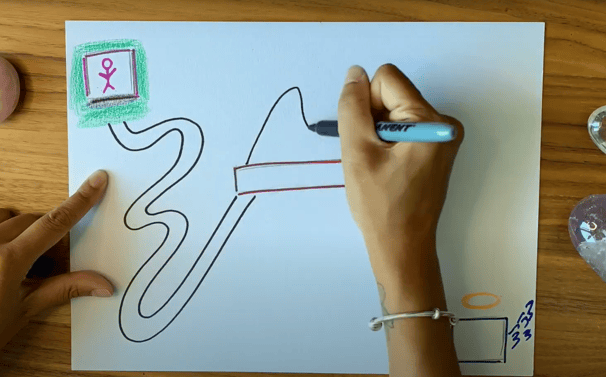
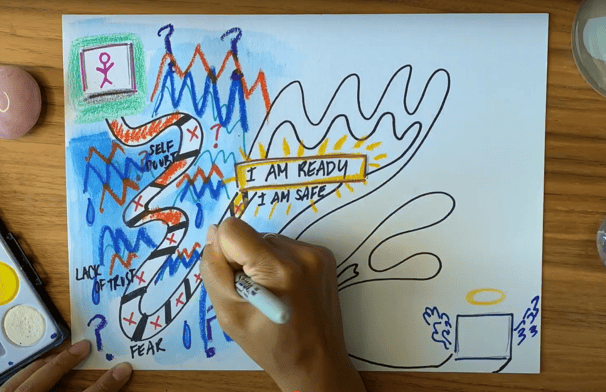
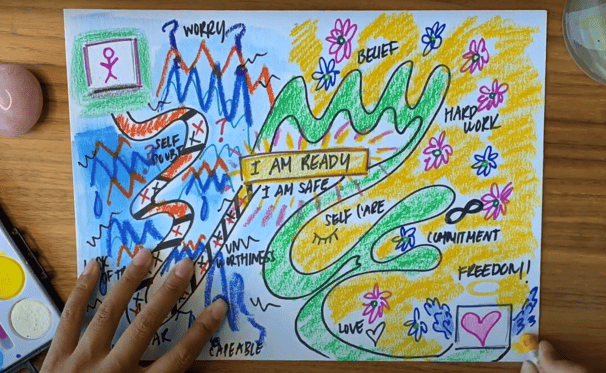



Personal Reflection
Activity 2 – Roadmap of Change
Art Supplies
Mixed media drawing paper or sketchbook
Coloured markers, pencils, paints, or crayons
Directions
This exercise explores the Bridges Transition Model, which highlights the three stages people experience during times of change: 1) The Ending, where you let go of the old; 2) The Neutral Zone, a time of uncertainty and exploration; and 3) The New Beginning, where you embrace the new.
Step 1: You’ll start by creating a personalized road map for your journey. Begin by drawing a starting point, a midpoint, and an endpoint on your page. Make sure to have plenty of space between each point. Next, join these points together with a road or path. Let your roadway/path take any shape or form that you wish.
Step 2: In the first half of your map, write and draw all the emotions you're experiencing as you begin taking steps forward on this journey. Use words, images, and colours to capture these feelings.
Step 3: The midpoint is going to be an affirmation. Write an empowering “I am” statement that makes you feel motivated to keep moving forward. For example, “I am ready to embrace change.”
Step 4: Now begin to describe through colours, words, and images the second half of your journey. Think about what would support you and make the transition easier and add them to your drawing.
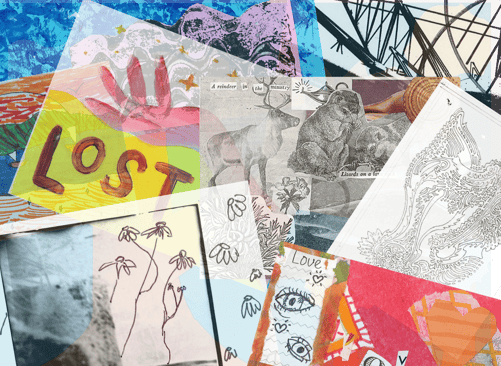



Prepare a Calm Space for Creative Exploration
Take a few moments to prepare a peaceful, nurturing space for yourself. You might begin by gently tidying the area and gathering any art supplies you’ll need. When you’re ready, light a candle or some incense to symbolize the start of this journey. If it feels soothing, put on some soft, relaxing music—acoustic, ambient, or nature-inspired sounds can help create a serene atmosphere. (If you’d like recommendations, consider exploring Yellow Brick Cinema on YouTube.) Let the gentle glow of the candle and the tranquil music guide you into a place of ease, inviting you to be fully present for this creative, healing session.
The Art of Reconnecting
With Your Inner Child
None of us are born adults. We have to learn everything as we grow. Children do that in two, incredibly effective, ways: experience and play. For adults who want to keep learning and growing, joyfully, to thrive in a fast-changing world, it might be time to reconnect with our inner child.
No one's life is perfect though. For some, reconnecting with the childlike learner might also require facing some more difficult emotions. Sometimes we learned lessons as a child that get in the way of open learning and adaptation today. That's where inner child work comes in.
As children, we act out our experiences, thoughts, feelings, and dreams through our play. Our creativity becomes the basis of how we prepare for the real world.
Adolescence is a time of discovery, but it can also be painful. As we grow, we begin developing expectations of the world. Sometimes, those expectations fail us. We have broken hearts, we have frustrations, we have dreams that just don't materialize. At some point, many of us stop playing and start letting our experiences dictate who we are and what we want.
Where is the line that separates an adult life from childhood? And not just a number or an arbitrary age of majority. After all, we're always growing. The balance shifts when we stop playing. At that point, we spend little time imagining what could be and focus on what our experiences dictate.
Many of us never take the time to reconnect with these parts of our inner selves. Understanding inner child work can help us heal our long-standing hurts and allow us to play again. This kind of work unlocks our creativity, joy, passion, and potential.
What is an Inner Child?
The concept of the inner child isn’t merely a poetic metaphor. It refers to a psychological construct, a subconscious remnant of the child we once were. This inner child, formed and moulded by our early experiences, continues to exist within us, often influencing our reactions, behaviours, and emotional responses.
Like a physical child, the inner child can be healthy or wounded. It can express joy, curiosity, and innocence or carry the burden of trauma, disappointment, and unmet needs. Understanding and acknowledging this inner child is a vital step in self-discovery and emotional healing.
What is Inner Child Work?
Imagine that you're 5 years old. You're in school playing with the other children in your kindergarten class. While running around on the playground, you trip and fall. The other kids laugh at you.
You may not remember exactly what happened. You may not even remember who was there or how old you were. But what you do remember is the feeling of shame, the tears in your eyes, the pain of your skinned knee. You may even remember saying to yourself “I'm never going to make a fool out of myself like that again.”
The knee may have healed, but you’re dragging the scars into adulthood. You’re no longer in control. Twenty or fifty years later, your inner five-year-old is still running the show. Even when it might work to your advantage to take a risk, you can’t let go of what happened on the playground — even if you don’t remember it.
Inner child work is a therapeutic process that involves communicating with, understanding, and healing your inner child. It’s a journey into your past, revisiting your childhood experiences, emotions, and memories. It involves understanding how these past elements influence your current life and then working towards resolving any unresolved issues, traumas, or unmet needs. Inner child work is about giving your inner child a voice and a space in your adult life. It’s about listening, understanding, accepting, and ultimately healing.
Why is Inner Child Work Important?
The significance of inner child work cannot be overstated. Many of the challenges we encounter as adults can often be traced back to our early experiences, our formative years. Our reactions, emotions, and behaviours in adulthood are frequently linked to these past experiences. Inner child work is essentially the process of unravelling the threads of our past to gain insight into our present. It allows us to examine these roots and core beliefs that shape our lives in ways we may not be aware of. We can start making profound changes by understanding our inner child. Inner-child work helps us revisit and understand inner-child wounds and lead to improved emotional health, better relationships, and a deeper sense of self-awareness.
Benefits of Inner Child Work
Primarily leading to improved emotional health, there are several other significant benefits associated with inner child work. It helps us address unresolved emotions and traumas from childhood. Reduces feelings of anxiety and depression, enhances our self-esteem and generally improves relationships and our emotional well-being.
Improved Self-Understanding: Inner child work allows you to understand yourself better- your motivations, fears, reactions and behaviours.
Better Relationships: Understanding your inner child can help you understand your relationship patterns. You can work on your fear of abandonment, trust issues, and early attachment trauma.
Healing from Trauma: It helps you heal from past traumas influencing your adult life.
Understanding Your Inner Child
Understanding your inner child is a journey of introspection, a voyage back to your earliest memories and experiences. It’s about reflecting on those experiences, understanding how they’ve shaped you, and acknowledging the emotional residue they might have left. This journey might not always be easy, but it’s necessary for healing.
Your inner child is essentially your emotional self. It’s that part of you that experienced joy, fear, love, and hurt as a child. As you age, these experiences don’t disappear; they’re stored in your subconscious and continue influencing your emotional responses. Understanding your inner child means understanding these influences and the reasons behind your emotions and behaviours.
1. Uncovering Childhood Trauma and Traumatic Events
Uncovering childhood trauma is essential to understanding your inner child. Trauma doesn’t have to mean catastrophic events. It can also refer to emotional experiences that were too overwhelming for your young self to process.
Such traumatic events might include neglect, abuse, losing a loved one, or any experience that left you feeling scared, helpless, or insecure. If left unaddressed, they can continue to impact your emotional health in adulthood. Uncovering these traumatic experiences helps you begin the healing process.
2. Examining Childhood Wounds
Childhood wounds often run deeper than we imagine. They’re not always the result of trauma. They can also stem from unmet needs – lack of love, validation, security, or acceptance.
These wounds might manifest as feelings of unworthiness, insecurity, fear, or rejection. Examining these wounds, their origins and their impacts can help heal your inner child. This process might involve revisiting painful memories, but remember, the goal is not to dwell in pain but to understand it, validate it, and eventually let it go.
Connecting With Your Inner Child
Connecting with your inner child is about fostering a relationship with that part of you that holds your childhood experiences and emotions. It’s about creating a dialogue with your inner child, listening to its fears, needs, and pains. Learn to comfort your inner child to offer it the love and care it may have lacked.
Connecting with your inner child is not about re-living the past or wallowing in past trauma. Instead, it’s about understanding the past, learning from it, and using those insights to nurture your present and future self.
Establishing a Safe Space for Healing and Exploration
Creating a safe space for your inner child is crucial for this healing journey. This space could be a physical location, like a peaceful corner of your house, or a mental space of mindfulness and self-compassion.
Establishing a safe space allows you to feel your emotions without judgment. It’s where you validate your inner child’s experiences and assure that it’s safe, that it’s okay to express its feelings, and that it’s okay to be vulnerable.
What Is Inner Child Therapy and Who Is It For?
Inner child therapy is a therapeutic approach that focuses on addressing the inner child’s needs, wounds and emotions. It’s an integral part of many healing journeys, particularly for people who have experienced childhood trauma or neglect.
However, inner child therapy is not just for people with significant childhood trauma. It’s for anyone seeking to understand themselves better, to improve their emotional health, or to break free from destructive patterns. It’s for anyone looking to heal, grow, and live more authentically.
1. Understanding Your Pain
Understanding your pain is critical to inner child therapy. It’s about acknowledging the emotional wounds that your inner child has been carrying, possibly for many years. It’s about validating your past experiences and their impact on your life.
Understanding your pain doesn’t come overnight. It requires patience, self-compassion, and often professional help. Note that the goal of understanding your pain is not to dwell in it but to heal it.
2. Building Compassion
A crucial part of healing your inner child is learning to feel compassion for that inner child. Compassion involves understanding your inner child’s pain and responding with kindness and care. It’s about treating your inner child with the same love, respect, and understanding that you would offer a real child.
Building compassion for your inner child also means building compassion for your adult self. It means acknowledging your strengths, efforts and progress on this healing journey. It means recognizing that healing takes time and that it’s okay to take that time.
3. Connecting With Imagination and Creativity
One of the most beautiful aspects of your inner child is its connection to your imagination and creativity. Your inner-child is that part of you that loves to dream, explore, and create. It’s that part of you that finds joy in simple things and sees the world with wonder and curiosity.
Connecting with your inner child can help you reconnect with these aspects of yourself. It can help you bring more creativity, spontaneity, and joy into your life. Whether it’s through art, play, or simply allowing yourself to dream, connecting with your inner-child can be a wonderful journey of self-discovery and self-expression.
How to Heal Your Inner Child?
The journey to heal your inner child is personal and may look different for everyone. Consider the following steps to heal your inner child.
1. Acknowledge your inner child
The first step towards healing is acknowledgement. Acknowledge the existence of your inner child and its experiences. Acknowledge its pain, its fears, and its needs. This acknowledgement is the first step towards understanding and healing.
2. Hug yourself daily
This might sound simple, but physical self-comfort can be very healing. A daily hug can serve as a physical reminder that you are there for your inner child, that you care about it, and that you are committed to its healing.
3. Picture a happy childhood moment
Remembering happy moments from your childhood can help your inner child feel safe and loved. It can also help you connect with the joyful, innocent aspects of your inner child.
4. Mirror work
Mirror work involves looking at yourself in the mirror and speaking positive affirmations to your reflection. This can be a powerful tool for building self-love and self-compassion, both crucial for healing your inner child.
5. Practice self-compassion
Be patient with yourself. Healing takes time, and it’s okay to make mistakes along the way. Remember, it’s not about being perfect, it’s about making progress.
6. Write a letter to your inner child
Writing a letter to your inner child can be a beautiful way of connecting with it. You can use this letter to express your love for your inner-child, validate its experiences, and reassure it that you are there for it.
7. Identify your emotional triggers
Emotional triggers can often be linked to past experiences. By identifying these triggers, you can understand your emotional responses better and learn how to manage them more healthily.
8. Make time for play
Remember, your inner child is still a child. It needs time to play, to explore, to be creative. Make sure to include some play time in your daily routine.
9. Inner infant meditation
This involves visualizing your inner child and sending it love and healing energy through meditation. This can be a powerful way of connecting with your inner child on a deeper level.
10. Continue to educate yourself
Educate yourself about childhood development, emotional health, and inner-child work. The more you understand these topics, the better you will be equipped to support your inner child.
What Causes a Wounded Inner Child?
A wounded inner child is often the result of unmet emotional needs in childhood. This could be due to neglect, abuse, or any experience that left the child feeling unsafe, unloved, or invalidated. It is important to note that not all childhood experiences lead to a wounded inner child. A variety of factors can cause a wounded inner child, including:
Traumatic experiences during childhood, such as abuse, neglect, or abandonment.
Emotional wounds that were not properly addressed or healed during childhood.
Chronic rupture without repair, where a child cries out for help but is unheard by an emotionally unavailable caretaker.
Parents or guardians who are emotionally unavailable, neglectful, or unable to create a safe environment for their children.
Signs of a Wounded Inner-Child
Signs of a wounded inner child can vary widely. It’s worth noting that not all wounded inner children experience the same symptoms or behaviours. Some common signs of a wounded inner child are listed below.
Persistent feelings of emptiness, helplessness, and hopelessness.
Difficulty connecting with others in healthy ways.
Mental health issues such as anxiety, depression, addiction, eating disorders, and C-PTSD.
Physical conditions like migraines, chronic fatigue syndrome, and fibromyalgia.
People-pleasing behaviour, trouble saying no, difficulty setting and enforcing boundaries.
Conclusion
The journey to healing your inner child may not always be easy, but it’s definitely worth it. It’s a journey of self-discovery, self-compassion, and self-growth that can lead to better emotional health, improved relationships, and a deeper connection with yourself. If you find that you’re frustrated, angry, or feeling stuck, it might be your inner child asking for support. Understanding how your traumatic experiences impact your choices today can help you get unstuck.
From: How Inner Child Work Enables Healing and Playful Discovery and Understanding and Healing Your Inner Child: A Comprehensive Guide
Articles
Why Is Everyone Working on Their Inner Child?
Inner Child Healing: 35 Practical Tools for Growing Beyond Your Past
Reconnecting With Your Inner Child
Videos
Give Your Inner Child Permission to Heal | Kristin Folts (12 minutes)
Reparenting Our Inner Child (4 minutes)
Connect With Your Inner Child | Visualization Exercise (6 minutes)
Continue Your Learning
Art Supplies
Drawing paper or sketchbook
Coloured markers, pencils, or crayons
Creative Activity
Directions
Now that you're prepared, here are the steps:
Step 1: Draw Your Inner Child
Take a moment to connect with the child within you. Close your eyes; see or feel a child near you. Notice the colour of their hair, notice their height, posture, clothing. Open your heart and feel yourself accepting this child exactly as they are, even if the child is angry, sad, or frightened.
Using your non-dominant hand, draw your inner child. Allow the child to guide your hand. Let the true expression of your inner child be shown.
Don't judge what is coming out. You're simply holding space for your inner child. If something uncomfortable arises, let it be. Keep encouraging your inner child to express themselves freely.
Step 2: Ask Questions
With your dominant hand, write down the following four questions on the paper, leaving space for answers:
1) What is your name?
2) How old are you?
3) What are you feeling right now?
4) What can I do to help you feel really good?
Step 3: Respond as the Inner Child
Now, switch back to your non-dominant hand. Imagine you are the child you just drew and respond to each question.
Write down the answers with your non-dominant hand, allowing your inner child to express themselves freely.
After you finish your artwork, grab a pen and notebook and write down your answers to the following questions:
1) What feelings or memories arose as you drew your inner child?
2) How did it feel to use your non-dominant hand during the drawing process?
3) What insights did you gain from your inner child's responses to your questions?
4) Did any surprises or unexpected thoughts arise during this process?
5) How might your inner child's feelings or needs influence your actions as an adult?
6) How can you nurture or support your inner child moving forward?
Set an Intention
Before you begin, I invite you to close your eyes and take a few deep breaths. Let yourself be here right now in this moment. Turn your attention inwards, place your palms face down on the paper in front of you, and set an intention for this creative exercise. You may choose to say aloud or silently in your heart, "I embrace my inner child with unconditional love, honouring and validating their thoughts and feelings. I commit to listening to the needs of my inner child with an open heart and mind." Take a moment to give the paper gratitude for holding space for you today.
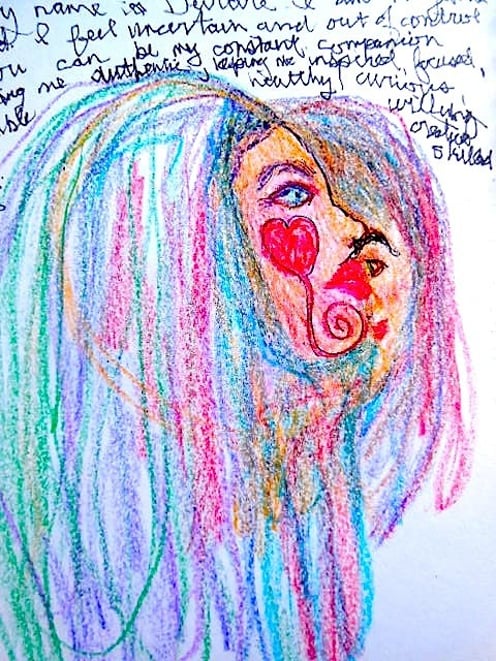
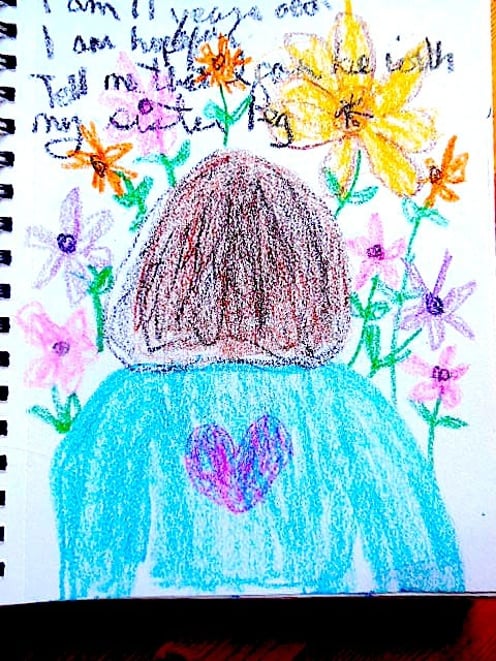

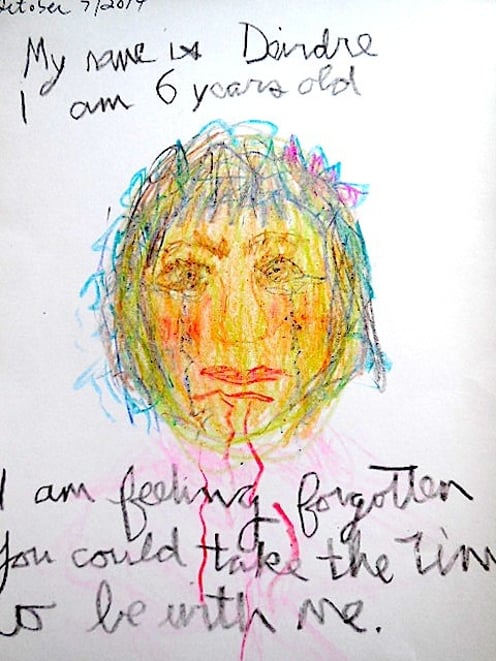








Personal Reflection
Prepare a Calm Space for Creative Exploration
Take a few moments to prepare a peaceful, nurturing space for yourself. You might begin by gently tidying the area and gathering any art supplies you’ll need. When you’re ready, light a candle or some incense to symbolize the start of this journey. If it feels soothing, put on some soft, relaxing music—acoustic, ambient, or nature-inspired sounds can help create a serene atmosphere. (If you’d like recommendations, consider exploring Yellow Brick Cinema on YouTube.) Let the gentle glow of the candle and the tranquil music guide you into a place of ease, inviting you to be fully present for this creative, healing session.
The Art of Opening Your Heart
"Keep breaking your heart until it opens."
– Rumi
The word ‘open’ has always conjured, for me, scenes of expansive space, broad horizons, reception, and exploration. What I often forget is that, in such beautiful ways, the world works in contrasts and they are often stark. Everything is cyclical; just like the tides and the phases of the moon, we go in and out of expansion and contraction.
So too, does the heart. Openness is often provoked by an explosion, a sudden blast of heat, a disarming presence, or a situation that leaves you without much to say. In these times, we fear the darkness. We forget about contrast. We beg for the light. In practice, we know that all things are temporary; we know that there is a symbiotic relationship between our perceived pain and our desired outcomes. There are always lessons in store.
Choosing Heart Over Ego
The heart is a great teacher in this way. It leads us into depths we had no idea existed so far within us, it shows us the parts we pretend are not there, and waves them in our face.
The heart has its own intelligence, its own methods for exploration and teaching. It is at once its own entity and an integrated leader with the other systems of the body and energy. Those who are tapped most fully into their ability to love (their heart energy), radiate this outward. It magnetizes. Other people can feel it, and even if not consciously, they are changed because of it.
We are impacting each other all of the time, in waves and great starts, in words and wordless interactions, in embraces and calculated mistreatments.
The choice remains to lead with the heart over the ego when the aim is to have the most interesting life. The richest experience. The most irrefutable aliveness. The most comprehensive humanity.
Laying Down Your Arms
There is such bravery in living when you are broken open that is hard-pressed to be found elsewhere in many instances. Love is the fuel for so much of our experience, all of it, really, and we live and die to experience this ultimate alignment. We take passionate action and enraptured planning to an all-time high in the quest for this vibration, this elevating form of pure source.
What is incorrigible information underneath it all is that we needn’t work so hard. We must simply surrender. Those of us on a spiritual or yogic path tend to resonate with this word on a variety of levels, but many of us who are drawn to exploring the outer limits of ourselves are born with a fierceness that can be quite unshakeable. We love challenges–of ourselves, of our beliefs, of our bodies, we love the opportunity to grow. What this can also mean is that we love to fight, we love to embody the warrior.
We think of the warrior as being emblematic of strength in compassionate warfare, but so often, being a warrior means laying down your arms.
In the greatest sense, to awaken the open heart, to invigorate your full potential, you must let the intensity and heat of leading with your heart burn off all of the other things that are getting in the way–like the desire to struggle.
Saying ‘Yes’ to Being Open
Spiritual growth is so often like taking up residence in a furnace, in a cosmic bonfire imploding in on itself, the path is the undaunted ownership of one foot in front of the other, in the most stacked of flames.
When we answer the call to live fully, we accept that this means in great joy and in great sadness. When we welcome intensity, we trust that it means nothing is going to be subtle anymore. We learn to find stillness in this, on our mats, in our meditations, with our breath–yet, still, the experience of heightened awareness and sensation is there.
It will always be there, as a reminder that we have bodies, yet we are not just bodies. We are interconnected and raw and vibrating and reaching out to each other without using our arms at all. We are walking force fields, little lightning bolts of everything imaginable, pared-down and packaged into lovely vessels that can kiss and fuse.
If we choose the road less traveled, the one where we say ‘yes’ to being wide open, we know that we are, in effect, choosing to be challenged. We are nodding our heads to being thrown and surprised as well as embraced and made warm. We are exclaiming with wide eyes and clapping our hands at the opportunity to face everything and rise.
Surrender is key. Persistence is necessary. Bravery is fuel. Courage is emblematic.
Agreeing to an Explosive Life
Awakening the open heart has very little to do with being undiscerning about where you throw your loving energy. It has much to do with being discerning about remaining open even when you feel like you have been grated clean and left in the rain. There is a lesson there, in that wetness.
Each experience we have is simultaneously being had or has been had by everyone around us. It is impossible to feel alone in this, in the openness of being, in letting the heart lead the way, in allowing it to be the guiding light and the conjurer of our everyday comings and goings, reachings, and failings.
When we choose to rouse our open heart, to awaken her, to let her beat at the front lines, we are agreeing to an explosive, extraordinary life. We are agreeing to push past what we are often told is acceptable in terms of range of feeling.
How Open is Your Heart?
We are consciously choosing to deviate from the mundane, the restricted, the oppressed, and the self-censored. To be truly open-hearted is to beat with the pulse of the divine, in light and dark, in challenge and ease, in acceptance and turmoil, and always in surrender to whatever may come.
The truly adventurous life leaves no stone unturned, and the path of the explorer begins with the commitment to grow wider between the ribs every day.
Articles
How to Open Your Heart So More Love Can Get In
How to Ease the Pain of Heartache
Why Is it So Hard To Keep Your Heart Open
Videos
Tara Brach on Nurturing Our Heart with Self Compassion (11 minutes)
The Fascinating Relationship Between the Heart and Brain (4 minutes)
5 Minute Loving Kindness Meditation | Open Your Heart to Warmth and Loving Kindness (5 minutes)
Continue Your Learning
Art Supplies
Mixed media paper
Drawing materials of your choice (felt markers, paints, crayons, coloured pencils, pastels, etc.)
Creative Activity
Directions
Now that you're prepared, here are the steps:
Step 1: Create the Doorway to Your Heart
Take your piece of paper and fold both edges towards the center. This represents the doorway to your heart.
Step 2: Decorate the Outside of the Door
Reflect on what guards your heart. Think about any barriers, walls, or protective measures you have in place to guard your heart from pain, loss, and fear.
Use your drawing materials to decorate the outside of the door. Include symbols, lines, shapes, and colours that represent the protection you have put around your heart.
Step 3: Explore the Inside of Your Heart
Open the folded paper to reveal the inside of your heart.
Take a moment to tune into the core of your heart. Notice the emotions that are present—joy, love, sadness, hope, pain. Reflect on the true nature of your heart and how you want to share your love with the world.
Use images and colours to express what lies inside your heart.
After you finish your artwork, grab a pen and notebook and write down your answers to the following questions:
1) What emotions surfaced for me as I decorated the outside of my heart?
2) How do I feel about the protective measures I’ve put in place? Are they serving me well?
3) What feelings and memories emerged as I explored the inside of my heart?
4) How do you wish to express and share your love with others?
5) In what ways can I gently begin to lower my walls to invite more love into my life?
6) What does my heart truly desire right now?
Set an Intention
Before you begin, I invite you to close your eyes and take a few deep breaths. Let yourself be here right now in this moment. Turn your attention inwards, place your palms face down on the paper in front of you, and set an intention for this creative exercise. You may choose to say aloud or silently in your heart, "Today, I gently acknowledge the walls around my heart. I give myself permission to explore and express my feelings through my art. I open myself to the love that surrounds me, allowing it to flow freely into my heart.” Take a moment to give the paper gratitude for holding space for you today.
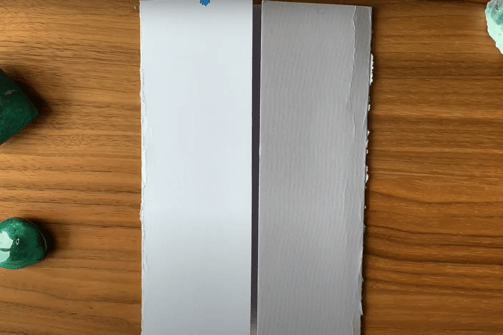
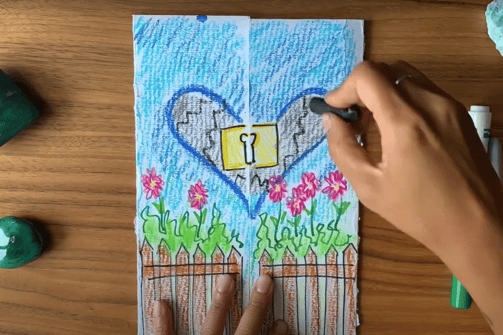

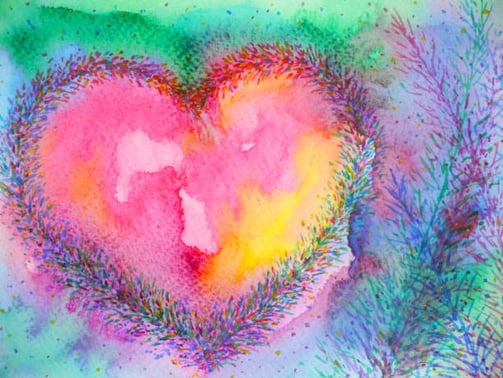

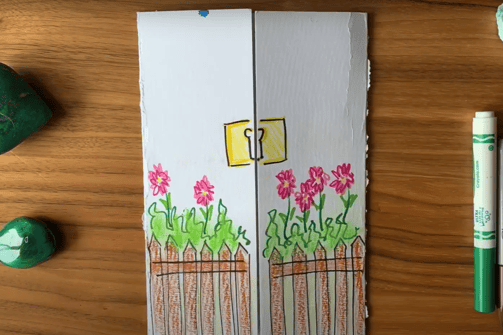

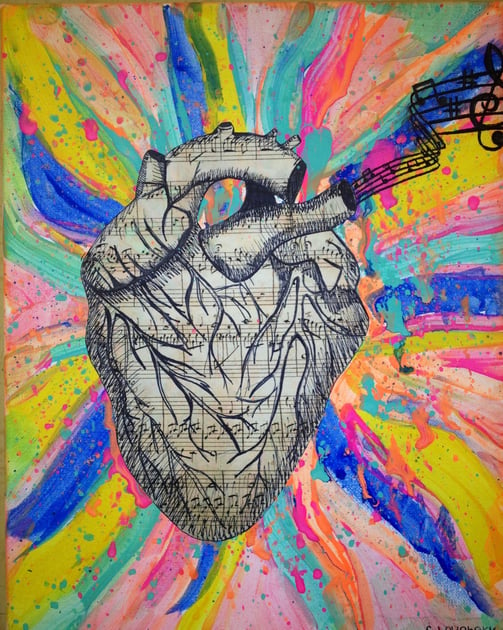
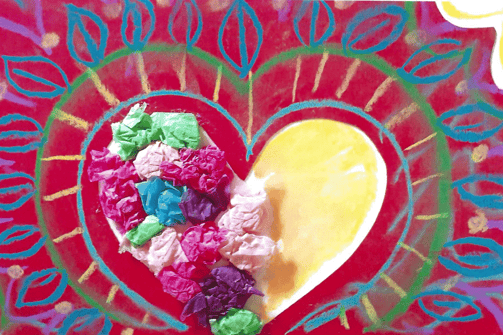
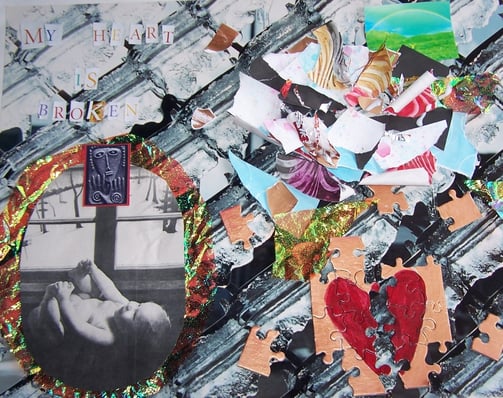










Personal Reflection
Prepare a Calm Space for Creative Exploration
Take a few moments to prepare a peaceful, nurturing space for yourself. You might begin by gently tidying the area and gathering any art supplies you’ll need. When you’re ready, light a candle or some incense to symbolize the start of this journey. If it feels soothing, put on some soft, relaxing music—acoustic, ambient, or nature-inspired sounds can help create a serene atmosphere. (If you’d like recommendations, consider exploring Yellow Brick Cinema on YouTube.) Let the gentle glow of the candle and the tranquil music guide you into a place of ease, inviting you to be fully present for this creative, healing session.
The Art of Self-Compassion
Many of us believe being self-critical and hard on ourselves is a good thing. We mistakenly think that being competitive and pushing ourselves hard is required for success. Research, however, is proving these theories wrong. Most of us don’t stop to consider whether our self-critical and competitive attitude are helping us achieve our goals. We don’t realize that they are actually standing in our way.
Scientific data shows that self-criticism makes us weaker in the face of failure, more emotional, and less likely to assimilate lessons from our failures. Studies are finding that there is a far better alternative to self-criticism: self-compassion.
Though the term “self-compassion” may sound like self-indulgence or may feel like a weakness, it is actually the secret to resilience, strength in the face of failure, the ability to learn from mistakes and to bounce back with greater enthusiasm.
An explosion of research into self-compassion over the last decade has shown its benefits for well-being. Individuals who are more self-compassionate tend to have greater happiness, life satisfaction and motivation, better relationships and physical health, and less anxiety and depression. They also have the resilience needed to cope with stressful life events such as divorce, health crises, and academic failure, and even combat trauma.
What Is Self-Compassion?
Self-compassion involves treating yourself the way you would treat a friend who is having a hard time—even if your friend blew it or is feeling inadequate, or is just facing a tough life challenge. The more complete definition involves three core elements that we bring to bear when we are in pain: self-kindness, common humanity (the recognition that everyone make mistakes and feels pain), and mindfulness.
For example, imagine that your best friend calls you after she just got dumped by her partner, and this is how the conversation goes.
“Hey,” you say, picking up the phone. “How are you?”
“Terrible,” she says, choking back tears. “You know that guy Michael I’ve been dating? Well, he’s the first man I’ve been really excited about since my divorce. Last night he told me that I was putting too much pressure on him and that he just wants to be friends. I’m devastated.”
You sigh and say, “Well, to be perfectly honest, it’s probably because you’re old, ugly, and boring, not to mention needy and dependent. And you’re at least 20 pounds overweight, your clothes don’t fit, and your hair is turning gray. I’d just give up now, because there’s really no hope of finding anyone who will ever love you. I mean, frankly, you don’t deserve it!”
Would you ever talk this way to someone you cared about? Of course not. But strangely, this is precisely the type of thing we say to ourselves in such situations—or worse. With self-compassion, we learn to speak to ourselves like a good friend. “I’m so sorry. Are you OK? You must be so upset. Remember I’m here for you and I deeply appreciate you. Is there anything I can do to help?”
When we mindfully observe our pain, we can acknowledge our suffering without exaggerating it, allowing us to take a wiser and more objective perspective on ourselves and our lives.
Can You Be Too Self-Compassionate?
Many people fear self-compassion is really just a form of self-pity. In fact, self-compassion is an antidote to self-pity. While self-pity says “poor me,” self-compassion recognizes that life is hard for everyone. Research shows that self-compassionate people are more likely to engage in perspective taking, rather than focusing on their own distress. They are also less likely to ruminate on how bad things are, which is one of the reasons self-compassionate people have better mental health.
The Physiology of Self-Criticism and Self-Compassion
When we criticize ourselves we’re tapping into the body’s threat-defense system (sometimes referred to as our reptilian brain). Among the many ways we can react to perceived danger, the threat-defense system is the quickest and most easily triggered. This means that self-criticism is often our first reaction when things go wrong.
Feeling threatened puts stress on the mind and body, and chronic stress can cause anxiety and depression, which is why habitual self-criticism is so bad for emotional and physical well-being. With self-criticism, we are both the attacker and the attacked.
Compassion, including self-compassion, is linked to the mammalian care system. That’s why being compassionate to ourselves when we feel inadequate makes us feel safe and cared for, like a child held in a warm embrace. Self-compassion helps to downregulate the threat response. When the stress response (fight–flight–freeze) is triggered by a threat to our self-concept, we are likely to turn on ourselves in an unholy trinity of reactions. We fight ourselves (self-criticism), we flee from others (isolation), or we freeze (rumination).
When we practice self-compassion, we are deactivating the threat-defense system and activating the care system. Oxytocin and endorphins are released, which helps reduce stress and increase feelings of safety and security.
Fear vs. Truth
Fear: Self-compassion will make us weak and vulnerable.
Truth: In fact, self-compassion is a reliable source of inner strength that confers courage and enhances resilience when we’re faced with difficulties. Research shows self-compassionate people are better able to cope with tough situations like divorce, trauma, or chronic pain.
Fear: Self-compassion is really the same as being self-indulgent.
Truth: It’s actually just the opposite. Compassion inclines us toward long-term health and well-being, not short-term pleasure (just as a compassionate mother doesn’t let her child eat all the ice cream she wants, but says, “eat your vegetables”). Research shows self-compassionate people engage in healthier behaviors like exercising, eating well, drinking less, and going to the doctor more regularly.
Fear: Self-compassion is really a form of making excuses for bad behavior.
Truth: Actually, self-compassion provides the safety needed to admit mistakes rather than needing to blame someone else for them. Research shows self-compassionate people take greater personal responsibility for their actions and are more likely to apologize if they’ve offended someone.
Fear: Self-criticism is an effective motivator.
Truth: It’s not. Our self-criticism tends to undermine self-confidence and leads to fear of failure. If we’re self-compassionate, we will still be motivated to reach our goals—not because we’re inadequate as we are, but because we care about ourselves and want to reach our full potential. Self-compassionate people have high personal standards; they just don’t beat themselves up when they fail.
Sometimes Life Is Hard. Can You Be Kind to Yourself?
Pain in life—loss, worry, heartbreak, hardship—is inevitable, but when we resist the pain, it usually just makes the pain more intense. It’s this add-on pain that can be equated with suffering. We suffer not only because it’s painful in the moment, but because we bang our head against the wall of reality—getting frustrated because we think things should be other than they are.
Another common form of resistance is denial. We hope that if we don’t think about a problem, it will go away. Research shows that when we try to suppress our unwanted thoughts or feelings, however, they just get stronger. Moreover, when we avoid or suppress painful thoughts and emotions, we can’t see them clearly and respond with compassion.
Mindfulness and self-compassion are resources that give us the safety needed to meet difficult experience with less resistance. Just imagine how you would feel if you were overwhelmed and a friend walked into the room, gave you a hug, sat down beside you, listened to your distress, and then helped you work out a plan of action. Thankfully, that mindful and compassionate friend can be you. It begins by opening to what is, without resistance.
After practicing speaking to herself compassionately for some months, Rafaella learned to hold herself and her anxiety with mindfulness and compassion, rather than fighting the experience. When she became anxious or even a little panicky, her inner dialogue went something like this, spoken from a compassionate part of herself: “I know you feel really scared right now. I wish things weren’t so difficult, but they are. I know there is tightening in your throat and some dizziness in your head. Still, I care for you and I’m here for you. You are not alone. We’ll get through this.” With a new, more compassionate inner voice, Rafaella’s panic attacks receded and she found she was much more capable of working with her anxiety than she had realized.
In a moment of struggle, we don’t practice to be free of our pain—we practice compassion because sometimes it’s hard to be a human being. Radical acceptance is like a parent comforting a child who has the 48-hour flu. The parent doesn’t care for the child to try to drive the flu away—the flu is going to leave in its own time. But because the child has a fever and feels bad, the parent comforts her as a natural response to suffering while the process of healing occurs. It’s like this when we try to comfort ourselves, too. When we fully accept the reality that we are imperfect human beings, prone to make mistakes and struggle, our hearts naturally begin to soften. We still feel pain, but we also feel the love holding the pain, and it’s more bearable.
When we fully accept the reality that we are imperfect human beings, prone to make mistakes and struggle, our hearts naturally begin to soften. Together, mindfulness and self-compassion form a state of warmhearted, connected presence that strengthens us during difficult moments in our lives.
Practicing Imperfection
Whenever you find yourself using self-compassion to try to make the pain go away or to become a “better person,” try shifting your focus away from this subtle form of resistance and practice compassion simply because we’re all imperfect human beings, living imperfect lives. And life is hard. In other words, practice being a “compassionate mess.”
By simply asking the question “What do I need now?” you allow yourself a moment of self-compassion, even if you can’t find an answer or don’t have the ability to meet your needs at the time.
Write a Letter to Yourself
You can find your compassionate voice by writing a letter to yourself whenever you struggle or feel inadequate or when you want to help motivate yourself to make a change. It can feel uncomfortable at first, but gets easier with practice.
Here are three formats to try:
1) Think of an imaginary friend who is unconditionally wise, loving, and compassionate and write a letter to yourself from the perspective of your friend.
2) Write a letter as if you were talking to a dearly beloved friend who was struggling with the same concerns as you.
3) Write a letter from the compassionate part of yourself to the part of yourself that is struggling.
After writing the letter, you can put it down for a while and then read it later, letting the words soothe and comfort you when you need it most.
Articles
The Scientific Benefits of Self-Compassion Infographic
Exploring the Meaning of Self-Compassion and Its Importance
The Transformative Effects of Mindful Self-Compassion
8 Powerful Self-Compassion Exercises and Worksheets
Videos
It Is Time for a Self-Compassion Break with Dr. Kristin Neff (9 minutes)
The Elements of Self-Compassion (3 videos, 1 minute each)
Self-Compassion: Learn How to Face Your Flaws With Love and Courage (6 minutes)
Self-Compassion (5 minutes)
Continue Your Learning
Art Supplies
Rag or paper towel
Watercolor or gouache paint
Cup with water
Brushes
Watercolor paper (any size)
Optional: Drawing media like coloured pencils or markers
Creative Activity
Directions
Now that you're prepared, here are the steps:
Step 1 - Expressing Difficult Thoughts and Feelings
Reflect on what you find challenging about yourself. This might include disappointments, regrets, feelings of hopelessness, or frustration. Now, create an image that represents these thoughts and feelings or your relationship with yourself. You can use abstract colours, shapes, symbols, and lines, or opt for a more realistic drawing—whichever way feels right to express these emotions.
Step 2 - Creating a Compassionate Response
On a new page, create an artwork that offers a compassionate response to the first image. Consider how you can soften and bring kindness to the initial depiction. Use any shapes, lines, and colours that convey a more compassionate, gentle, or kind perspective on the first picture. If this feels difficult, try thinking about what a caring friend might say to comfort you. Then, translate that supportive advice into a visual image.
From: Thirsty for Art
After you finish your artwork, grab a pen and notebook and write down your answers to the following questions:
1) What emotions surfaced as you created the first image?
2) In what ways did creating the second, more compassionate image impact your perception of the first image?
3) How do you feel about yourself after completing this exercise?
4) What did you learn about your capacity for self-compassion and self-love?
Set an Intention
Before you begin, I invite you to close your eyes and take a few deep breaths. Let yourself be here right now in this moment. Turn your attention inwards, place your palms face down on the paper in front of you, and set an intention for this creative exercise. You may choose to say aloud or silently in your heart, "I am worthy of love and compassion. Through this creative exercise, I embrace all parts of myself with kindness and understanding." Give the paper gratitude for holding space for you today.

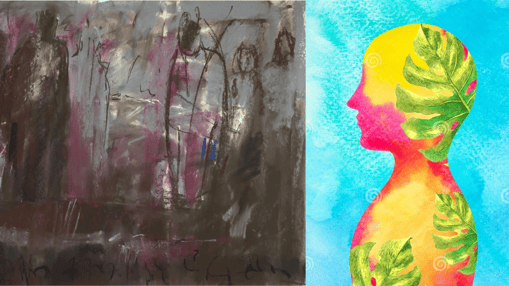
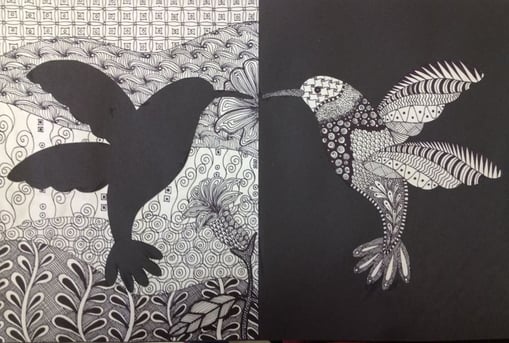



Personal Reflection
Prepare a Calm Space for Creative Exploration
Take a few moments to prepare a peaceful, nurturing space for yourself. You might begin by gently tidying the area and gathering any art supplies you’ll need. When you’re ready, light a candle or some incense to symbolize the start of this journey. If it feels soothing, put on some soft, relaxing music—acoustic, ambient, or nature-inspired sounds can help create a serene atmosphere. (If you’d like recommendations, consider exploring Yellow Brick Cinema on YouTube.) Let the gentle glow of the candle and the tranquil music guide you into a place of ease, inviting you to be fully present for this creative, healing session.
The Art of Relationships
What makes for a happy life? Philosophers have pondered this question for millennia, coming up with different theories and recommendations for people to follow, but not necessarily having any hard evidence to prove their ideas. That’s what inspired the long-running Harvard Study of Adult Development.
Starting in the 1930s, researchers tracked men from different neighborhoods in the Boston area over several decades, asking them to provide regular updates on their lives, including their current health, income, employment, and marital status. The men also filled out questionnaires and participated in interviews where they revealed their fears, hopes, disappointments, accomplishments, regrets, life satisfaction, and much more. This resulted in rich, in-depth data that researchers could use to assess how life circumstances, experiences, and attitudes affect well-being.
Findings from the study have been parsed over the years as patterns emerged. But now they’ve been put together into a book, The Good Life: Lessons From the World’s Longest Scientific Study of Happiness. Written by the study’s current director and associate director, Robert Waldinger and Marc Schulz, the book not only reveals what factors lead to a “good life,” but also why it’s never too late to nudge our own lives in a happier, healthier direction.
The Keys to Well-Being
It turns out the key to a long, healthy life isn’t necessarily obvious. “Contrary to what many people think, it’s not career achievement, or exercise, or a healthy diet,” write the authors—though those things matter, too, they add. Instead, “one thing continuously demonstrates its broad and enduring importance: Good relationships.”
How can the authors say this so definitively? After all, the study began with only white males in a select geographic area as participants (it’s since been broadened to include others). On the other hand, the authors can point to many other longitudinal studies representing more diverse groups, all of which conclude the same thing: that human connections are important for healthy development and longevity.
“People who are more connected to family, to friends, and to community, are happier and physically healthier than people who are less well connected,” they write.
This is both good news and bad. It suggests a practical way to improve our lives—by nurturing our relationships, no matter how bad things are. But loneliness and disconnection seem to be rampant in society—in part, the authors suggest, because of a culture that pushes us toward going it alone and overachieving at the expense of our relationships. If we don’t understand what makes us happy, they argue, we may end up choosing unwisely—for example, pursuing high-salaried jobs that take us away from our communities.
Their book acts as a kind of course corrective, countering myths about the good life. They support their assertions with scientific findings from many sources, but also include life stories from the people involved in the Harvard study, sprinkled throughout the book. We learn that some men started out in life advantaged and acquired college degrees or great jobs, but they ended up lonely or dying prematurely. Meanwhile, other participants who’d faced more headwinds early in life fared well, finding a job that brought them meaning or a family life that helped them weather ups and downs.
People’s lives don’t always play out the same, of course. Many circumstances make it easier or harder to preserve our well-being—including whether we’ve suffered from the early loss of a parent, discrimination, child abuse, poverty, or illness. For example, Black Americans are more likely to die younger than white Americans because of the stresses of racism and poorer access to good health care. Yet having positive social ties still makes a difference in survival rates, say the authors, suggesting that relationships make us more resilient in the face of life’s hardships.
“There are cultural practices and systemic factors causing significant amounts of inequity and emotional pain. But the capacity of relationships to affect our well-being and health is universal,” they write.
How to Cultivate Better Relationships
Given the importance of relationships in a good life, the authors spend much of the book outlining how we can take our social connections in a more positive direction—whether that’s at home, with friends, at work, or in our communities. Here are some tips they offer.
Take stock by looking inward. The busyness of life can sometimes keep us from assessing the health of our relationships, to our detriment. But taking time to consider our current state of affairs can bring insights. Many of the participants in the Harvard study benefitted from being interviewed at regular intervals, because it helped them realize where they’d neglected their relationships and consider reaching out.
To help you take stock of your own social life, the authors provide a chart where you can make a list of the people in your life while noting the kind of relationship you have with them, the supports they provide, and how often you spend time together. Filling out the chart may clarify what relationships matter most and help you make decisions accordingly. For example, you might find you want to spend more time with the person who makes you laugh and less time with the person who drains you.
Consider how your needs may differ at different stages of life. For example, young adults may benefit from a wide variety of less intimate relationships, which can help them find work or romantic partnerships. The elderly may not need so many friends, but require a few intimates to keep them happy. While some studies find that happiness takes a nosedive in midlife, the Harvard study found that “the happiest and most satisfied adults [in midlife] were those who managed to turn the question ‘What can I do for myself?’ into ‘What can I do for the world beyond me?’” Knowing where you are in life may guide you in how to develop your social network—whether that’s zeroing in on family ties or volunteering in your community.
Prioritize your relationships and be present. Many of us think we don’t have enough hours in the day to give to developing our relationships. But even when we’re not on duty at work or at home, we are probably missing opportunities to spend quality time with the people who matter to our happiness. Too many of us spend our spare moments zoning out with social media or barely noticing who and what is around us, argue the authors. Taking time to bring your full attention to other people when you’re with them is a gift to them and to yourself that can build more closeness. For example, having a close friend at work brings all kinds of benefits.
To be present in relationships, the authors suggest showing curiosity (even if you think you know someone well), listening carefully when people talk, expressing interest, and showing affection (when appropriate), all of which can make even short interactions with others more meaningful—and beneficial to all.
When difficulties arise, be reflective, not reflexive. When conflicts arise in relationships—or even when we’re just overwhelmed with other challenges in life—we may go on autopilot and withdraw from others or lash out at them. Neither of these are ideal ways to manage stress or anger, as they aren’t focused on preserving closeness or working through difficulty. Trying to suppress or avoid emotions is rarely a good strategy for health and well-being and can backfire when it comes to preserving relationships.
The authors suggest that, instead, we take a moment to use emotion regulation strategies to help us deal with anger, frustration, or stress before engaging in conflict resolution with someone else. “The key is to try to slow things down where you can, zoom in, and move from a fully automatic response to a more considered and purposeful response that aligns with who you are and what you are seeking to accomplish,” they write. This can help you be less reactive and give you a better chance of working through issues—whether relationship issues or personal ones.
Let people know how much they matter to you. The book includes many more ideas of how to preserve or enhance relationships, offering hope that change can happen at any stage of life when we use the right tools. One of those tools is expressing gratitude—something we may forget to do in our everyday lives. While many passages in the book inspired me to want to act in support of my own relationships, letting people know they mattered to me was the most inspiring—and the one I took to heart:
“Think about someone, just one person, who is important to you. . .Think about what they mean to you, what they have done for you in your life. Where would you be without them? Who would you be? Now think about what you would thank them for if you thought you would never see them again. And at this moment—right now—turn to them. Call them. Tell them.”
From: What the Longest Happiness Study Reveals About Finding Fulfillment
Articles
Want to Improve Your Relationship? Start Paying More Attention to Bids
How to Have Healthy Family Relationships With Less Stress
This 5min Relationship Check-In Will Transform Your Marriage
Videos
The Three Requirements of a Good Relationship (5 minutes)
Marriage - Love Lessons from a Beautiful Couple (12 minutes)
Relationships: From Reactivity to Re-Choosing Love, with Tara Brach (51 minutes)
Continue Your Learning
Activity 1 - Create a Couples Vision Board
Art Supplies
Poster board or foam-core board
Magazines and couples memorabilia (like ticket stubs or photos)
Scissors, glue sticks, tape
Markers, paint, stickers, ribbon (depending on how creative you want to be)
Creative Activities
Directions
As a couple, it's important to visualize and align your dreams for the future. Creating a shared vision board can help you explore and express your collective aspirations through art. Similar to a traditional vision board, it allows you to visualize your goals together. Here are a few ways to approach the activity:
One Shared Board: Design a single vision board collaboratively, representing both your individual dreams and your shared aspirations as a couple.
Side-by-Side Boards: Create separate boards for each person, then dedicate a central space to showcase your joint goals and dreams.
Overlapping Area: Design individual sections on a larger board, but include a central area specifically for your shared couple's vision.
Once your supplies are gathered together, the fun begins! Start by going through magazines or online images to find words and pictures that represent your goals and dreams. Cut out the images most appealing to you and begin arranging them on the board.
Once you’ve finished your artwork, take a moment to explore your experiences before discussing the following questions with your partner:
1) What did I learn about my partner or our relationship through the activity (activities)?
2) Were there any surprising insights or realizations that I came to during the creation process?
3) How did my partner’s artwork make me feel, and what did it reveal about their perspective?
4) What strengths in our relationship were highlighted through the art? What areas in need of improvement were revealed?
5) Are there any areas of our relationship that I now see differently after this activity?
6) How can I use the insights gained from the activity (activities) to improve our relationship?
Art therapy can be a powerful tool for couples and families. We understand that every relationship is unique, so instead of a one-size-fits-all activity, we've provided four engaging art therapy exercises that you can do with a partner or family member. Choose the one that resonates most with you and get ready to explore your relationship in a creative and meaningful way.
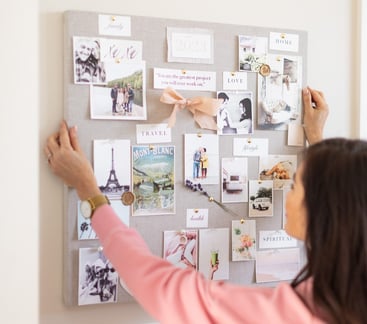



Personal Reflection
Activity 2 - Heartfelt Reflection
Art Supplies
Mixed media paper
Pencil (for outlining)
Scissors and tape or glue
Assorted art supplies: markers, paint, pastels, watercolour, pencil crayons
Directions
Step 1: Begin by drawing the outline of an animal that you think best represents your partner. Have your partner do the same for you.
Step 2: Inside the animal, draw or write 1-3 pet peeves about the other person. Try not to bring in relationships with other people, as this could get heated quickly. Instead, focus on small things like habits.
Step 3: Spend some time embellishing your artwork.
This activity opens up conversation which allows both partners to discuss their habits. If certain habits bother you, ask your partner why they do them. The reason could be as simple as “I’m too lazy” or “I don’t have the time.” By having this open discussion, you both learn more about each other’s habits, thought processes, and personalities in a compassionate way. This approach avoids criticism and harsh words, helping you find a middle ground.
Activity 3 - Animal Pet Peeves
Art Supplies
Mixed media paper
Pencil (for tracing or outlining)
Assorted art supplies: markers, paint, pastels, watercolour, pencil crayons
Directions
Step 1: Start by drawing a large heart shape on a sheet of paper.
Step 2: Carefully cut the paper in half, right through the middle of the heart, so you have two halves.
Step 3: Think of 3-5 personality traits, skills, or habits that you appreciate about your partner. Your partner should do the same for you.
Step 4: On one half of the heart, write or draw the traits you appreciate about your partner. Your partner will do the same on the other half of the heart.
Step 5: Put the two halves of the heart back together with tape or glue. Take turns explaining to each other why you chose the specific traits you did. Try your best to really elaborate why you appreciate this trait about them.
This creative activity promotes healthy relationships by fostering mutual appreciation and understanding between you and your partner. By identifying and articulating the traits you value in each other, you can deepen your emotional connection and strengthen your bond. Reassembling the heart symbolizes the integration of your individual strengths, reinforcing your unity and commitment.
Activity 4 - Cherished Connections
Art Supplies
Mixed media paper
Assorted art materials: markers, paint, pastels, collage supplies, watercolour, pencil crayons
Directions
Step 1: Reflect on the people who matter most to you in life. Think about the special moments, shared experiences, and the profound impact they have had on your journey.
Step 2: Create unique and heartfelt art for each person. Let your emotions guide you as you choose the medium—whether it's a drawing, painting, collage, photograph, or another form of art that captures the essence of your relationship with them.
Step 3: Share your artwork with them as a sincere gesture of gratitude. Pour your heart into explaining why you created this piece and how much they mean to you. This heartfelt expression will deepen your connection and show them how cherished they truly are.
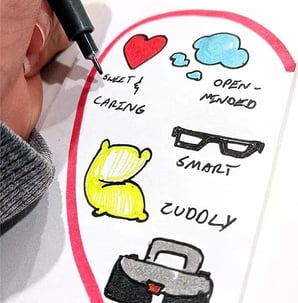
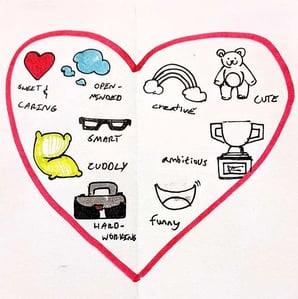


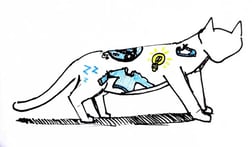



Prepare a Calm Space for Creative Exploration
Take a few moments to prepare a peaceful, nurturing space for yourself. You might begin by gently tidying the area and gathering any art supplies you’ll need. When you’re ready, light a candle or some incense to symbolize the start of this journey. If it feels soothing, put on some soft, relaxing music—acoustic, ambient, or nature-inspired sounds can help create a serene atmosphere. (If you’d like recommendations, consider exploring Yellow Brick Cinema on YouTube.) Take a moment to be still and begin connecting with your breath. Gently place your hands on the paper, inhaling deeply and exhaling slowly as you center yourself. This simple ritual sets an atmosphere of focus, indicating it’s time for creative exploration.
